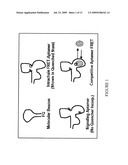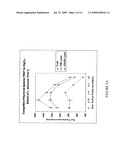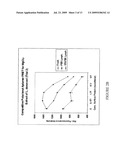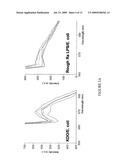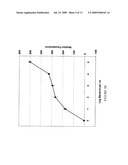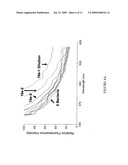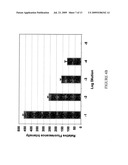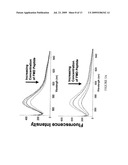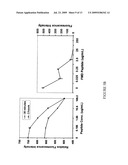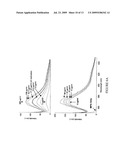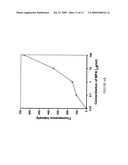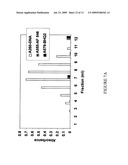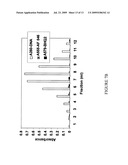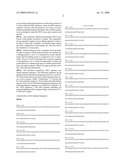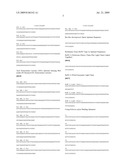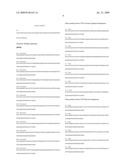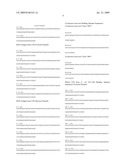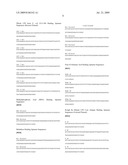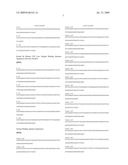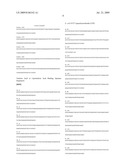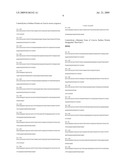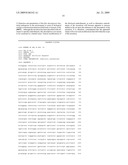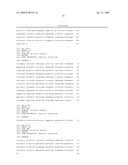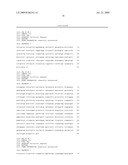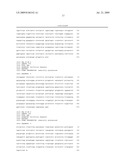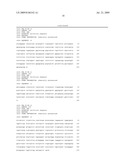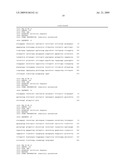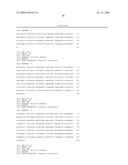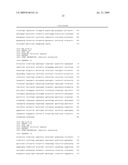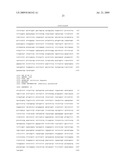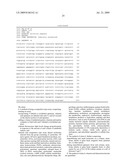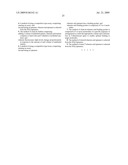Patent application title: Methods of producing competitive aptamer fret reagents and assays
Inventors:
John G. Bruno (San Antonio, TX, US)
John G. Bruno (San Antonio, TX, US)
Joseph Chanpong (Chapel Hill, NC, US)
IPC8 Class: AC12Q168FI
USPC Class:
435 6
Class name: Chemistry: molecular biology and microbiology measuring or testing process involving enzymes or micro-organisms; composition or test strip therefore; processes of forming such composition or test strip involving nucleic acid
Publication date: 2009-07-23
Patent application number: 20090186342
Claims:
1. A method of using a competitive type assay, comprising:running an
assay;incorporating F-labeled or Q-labeled aptamers, wherein said
aptamers are labeled with said F's and Q's located on the interior
portion of said aptamer;adding a volume of unlabeled analyte, wherein
said analyte competes to bind with said F-labeled or Q-labeled
analytes;wherein fluorescence light levels change proportionately in
response to the amount of said volume of unlabeled analyte; andwherein
said competitive type assay detects molecules selected from the group
consisting of: pesticides, OP nerve agents, OP nerve agent breakdown
products, acetylcholine (ACh), acyl homoserine lactone (AHL) and other
quorum sensing (QS) molecules, natural and synthetic amino acids and
their derivatives, histidine, histamine, homocysteine, DOPA, melatonin,
nitrotyrosine, short chain proteolysis products, cadaverine, putrescine,
polyamines, spermine, spermidine, nitrogen bases of DNA or RNA,
nucleosides, nucleotides, nucleotide cyclical isoforms, cAMP, cGMP,
cellular metabolites, urea, uric acid, pharmaceuticals, therapeutic
drugs, illegal drugs, narcotics, hallucinogens, gamma-hydroxybutyrate
(GHB), cellular mediators, cytokines, chemokines, immune modulators,
neural modulators, inflammatory modulators, prostaglandins, prostaglandin
metabolites, explosives, trinitrotoluene, explosive breakdown products or
byproducts, peptides and their derivatives, such as poly-D-glutamic acid
(PDGA) and similar bacterial capsule materials, macromolecules, proteins,
bacterial surface proteins, glycoproteins, lipids, glycolipids, nucleic
acids, polysaccharides, lipopolysaccharides or LPS components,
lipoteichoc or teichoic acids, viruses, whole cells, spores or
endospores, and subcellular organelles or cellular fractions.
2. The method of claim 1, further comprising:immobilizing said small molecules on a column, membrane, plastic or glass bead, magnetic bead, quantum dot, or other matrix;eluting immobilized aptamers from said column, membrane, plastic or glass bead, magnetic bead, or other matrix by use of 0.2-3.0 M sodium acetate at a pH of between 3 and 7.
3. The method of claim 1, wherein said detected molecules are quantified.
4. A method of using a competitive type assay, comprising:running an assay; andincorporating an aptamer, wherein said aptamer is selected from the SEQ Aptamers.
5. The method of claim 4, further comprising:adding a volume of unlabeled analyte, wherein said analyte competes to bind with said F-labeled or Q-labeled analytes; andwherein fluorescence light levels change proportionately in response to the amount of said volume of unlabeled analyte.
6. A method of using a competitive type assay, comprising:running an assay;incorporating an aptamer;wherein said aptamer has a binding pocket; andwherein said binding pocket is comprised of 3 to 6 nucleotides.
7. The method of claim 6 wherein said binding pocket is comprised of 3 or more nucleotides of a specific sequence or arrangement to confer the appropriate volume and conformation in 3-dimensional space to enable optimal binding to target molecules.
8. The method of claim 6 wherein said aptamer is selected from the SEQ Aptamers.
9. The method of claim 7 wherein said aptamer is selected from the SEQ Aptamers.
Description:
CROSS-REFERENCE TO RELATED APPLICATIONS
[0001]This application is a continuation-in-part of copending U.S. application Ser. No. 11/433,283 filed on May 12, 2006, which is incorporated herein by reference.
BACKGROUND OF THE INVENTION
[0002]1. Field of the Invention
[0003]The present invention relates to the field of aptamer- and nucleic acid-based diagnostics. More particularly, it relates to methods for the production and use of fluorescence resonance energy transfer ("FRET") DNA or RNA aptamers for competitive displacement aptamer assay formats. The present invention provides for aptamer-related FRET assay schemes involving competitive displacement formats in which the aptamer contains fluorophores ("F") (is F-labeled) and the target contains quenchers ("Q") (is Q-labeled), or vice versa. The aptamer can be F-labeled or Q-labeled by incorporation of the F or Q derivatives of nucleotide triphosphates. Incorporation may be accomplished by simple chemical conjugations through bifunctional linkers, or key functional groups such as aldehydes, carbodiimides, carboxyls, N-hydroxy-succinimide (NHS) esters, thiols, etc.
[0004]2. Background Information
[0005]Competitive displacement aptamer FRET is a new class of assay desirable for its use in rapid (within minutes), one-step, homogeneous assays involving no wash steps (simple bind and detect quantitative assays). Others have described FRET-aptamer methods for various target analytes that consist of placing the F and Q moieties either on the 5' and 3' ends respectively to act like a "molecular (aptamer) beacon" or placing only F in the heart of the aptamer structure to be "quenched" by another proximal F or the DNA or RNA itself. These preceding FRET-aptamer methods are all highly engineered and based on some prior knowledge of particular aptamer sequences and secondary structures, thereby enabling clues as to where F might be placed in order to optimize FRET results.
SUMMARY OF THE INVENTION
[0006]The nucleic acid-based "molecular beacons" snap open upon binding to an analyte or upon hybridizing to a complementary sequence, but beacons have always been end-labeled with F and Q at the 3' and 5' ends. The present invention provides that F-labeled or Q-labeled aptamers may be labeled anywhere in their structure that places the F or Q within the Forster distance of approximately 60-85 Angstroms of the corresponding F or Q on the labeled target analyte to achieve quenching prior to or after target analyte binding to the aptamer "binding pocket" (typically a "loop" in the secondary structure). The F and Q molecules used can include any number of appropriate fluorophores and quenchers as long as they are spectrally matched so the emission spectrum of F overlaps significantly (almost completely) with the absorption spectrum of Q.
[0007]A process in which F and Q are incorporated into an aptamer population is generally referred to as "doping." The present invention provides a new method for natural selection of F-labeled or Q-labeled aptamers that contain F-NTPs or Q-NTPs in the heart of an aptamer binding loop or pocket by PCR, asymmetric PCR (using a 100:1 forward:reverse primer ratio), or other enzymatic means. The present invention describes a strain of aptamer in which F and Q are incorporated into an aptamer population via their nucleotide triphosphate derivatives (for example, Alexfluor®-NTP's, Cascade Blue®-NTP's, Chromatide®-NTP's, fluorescein-NTP's, rhodamine-NTP's, Rhodamine Green®-NTP's, tetramethylrhodamine-dNTP's, Oregon Green®-NTP's, and Texas Red®-NTP's may be used to provide the fluorophores, while dabcyl-NTP's, Black Hole Quencher or BHQ®-NTP's, and QSY® dye-NTP's may be used for the quenchers) by PCR after several rounds of selection and amplification without the F- and Q-modified bases. The advantage of this F or Q "doping" method is two-fold: 1) the method allows nature to take its course and select the most sensitive F-labeled or Q-labeled aptamer target interactions in solution, and 2) the positions of F or Q within the aptamer structure can be determined via exonuclease digestion of the F-labeled or Q-labeled aptamer followed by mass spectral analysis of the resulting fragments, thereby eliminating the need to "engineer" the F or Q moieties into a prospective aptamer binding pocket or loop. Sequence and mass spectral data can be used to further optimize the competitive aptamer FRET assay performance after natural selection as well.
[0008]If the target molecule is a larger water-soluble molecule such as a protein, glycoprotein, or other water soluble macromolecule, then exposure of the nascent F-labeled and Q-labeled DNA or RNA random library to the free target analyte is done in solution. If the target is a soluble protein or other larger water-soluble molecule, then the optimal FRET-aptamer-target complexes are separated by size-exclusion chromatography. The FRET-aptamer-target complex population of molecules is the heaviest subset in solution and will emerge from a size-exclusion column first, followed by unbound FRET-aptamers and unbound proteins or other targets. Among the subset of analyte-bound aptamers there will be heterogeneity in the numbers of F- and Q-NTP's that are incorporated as well as nucleotide sequence differences, which will again effect the mass, electrical charge, and weak interaction capabilities (e.g., hydrophobicity and hydrophilicity) of each analyte-aptamer complex. These differences in physical properties of the aptamer-analyte complexes can then be used to separate out or partition the bound from unbound analyte-aptamer complexes.
[0009]If the target is a small molecule (generally defined as a molecule with molecular weight of ≦1,000 Daltons), then exposure of the nascent F-labeled and Q-labeled DNA or RNA random library to the target is done by immobilizing the target. The small molecule can be immobilized on a column, membrane, plastic or glass bead, magnetic bead, quantum dot, or other matrix. If no functional group is available on the small molecule for immobilization, the target can be immobilized by the Mannich reaction (formaldehyde-based condensation reaction) on a PharmaLink® column from Pierce Chemical Co. Elution of bound DNA from the small molecule affinity column, membrane, beads or other matrix by use of 0.2-3.0M sodium acetate at a pH of between 3 and 7.
[0010]The candidate FRET-aptamers are separated based on physical properties such as charge or weak interactions by various types of HPLC, digested at each end with specific exonucleases (snake venom phosphodiesterase on the 3' end and calf spleen phosphodiesterase on the 5' end). The resulting oligonucleotide fragments, each one bases shorter than the predecessor, are subjected to mass spectral analysis which can reveal the nucleotide sequences as well as the positions of F and Q within the FRET-aptamers. Once the FRET-aptamer sequence is known with the positions of F and Q, it can be further manipulated during solid-phase DNA or RNA synthesis in an attempt to make the FRET assay more sensitive and specific.
[0011]The competitive displacement aptamer FRET assay format of the present invention is unique. The competitive format generally requires a lower affinity aptamer in order to be able to release the F-labeled or Q-labeled target analyte and allow competition for the binding site. This may lead to less sensitivity in some assays.
[0012]When running an assay, an aptamer is incorporated. In order to interact with the target molecule, the aptamer has a binding pocket or site. It is anticipated in some embodiments that the binding pocket is comprised of 3 to 6 nucleotides. These 3 or more nucleotides have a specific sequence or arrangement so as to confer the appropriate volume and conformation in 3-dimensional space to enable optimal binding to the target molecule. Where the target molecule can be any of the type described herein.
[0013]The described competitive FRET aptamer uses unique aptamer sequences. The following sequences are all aptamers that bind foodborne pathogens such as E. coli O157:H7, Salmonella typhimurium and a surface protein from Listeria monocytogenes called "Listeriolysin." F=forward and R=reverse primed sequences. The invention described herein may use one or more of the following aptamer sequences (the following aptamer sequences are collectively referred to as the "SEQ Aptamers.") (The SEQ Aptamer identifiers are arranged alphabetically by aptamer target, and are listed 5' to 3' from left to right.):
Acetylcholine (ACh) Aptamer Sequences:
TABLE-US-00001 [0014]ACh1a For ATACGGGAGCCAACACCACGATACCCGCTTATGAATTTTAAATTAATTGT GATCAGAGCAGGTGTGACGGAT ACh1a Rev ATCCGTCACACCTGCTCTGATCACAATTAATTTAAAATTCATAAGCGGGT ATCGTGGTGTTGGCTCCCGTAT ACh 1b For ATACGGGAGCCAACACCAACTTTCACACATACTTGTTATACCACACGATC TTTTAGAGCAGGTGTGACGGAT ACh 1b Rev ATCCGTCACACCTGCTCTAAAAGATCGTGTGGTATAACAAGTATGTGTGA AAGTTGGTGTTGGCTCCCGTAT ACh 2 For ATACGGGAGCCAACACCACTTTGTAACTCATTTGTAGTTTGGGTTGCTCC CCCTAGAGCAGGTGTGACGGAT ACh 2 Rev ATCCGTCACACCTGCTCTAGGGGGAGCAACCCAAACTACAAATGAGTTAC AAAGTGGTGTTGGCTCCCGTAT ACh 3 For ATACGGGAGCCAACACCATTTCCCGCTTATCTTCATCCACTGCTTAGCAT ATGTAGAGCAGGTGTGACGGAT ACh 3 Rev ATCCGTCACACCTGCTCTACATATGCTAAGCAGTGGATGAAGATAAGCGG GAAATGGTGTTGGCTCCCGTAT ACh 5 For ATACGGGAGCCAACACCAGGCACTGTATCACACCGTCAAGAATGTGATCC CCTGAGAGCAGGTGTGACGGAT ACh 5 Rev ATCCGTCACACCTGCTCTCAGGGGATCACATTCTTGACGGTGTGATACAG TGCCTGGTGTTGGCTCCCGTAT ACh 6 For ATACGGGAGCCAACACCATGTCATTTACCTTCATCATGACAGTGTTAGTA TACGAGAGCAGGTGTGACGGAT ACh 6Rev ATCCGTCACACCTGCTCTAGGGGATCAAAGCTATGCGACCATGCGAGTGG ATACTGGTGTTGGCTCCCGTAT ACh 7 For ATACGGGAGCCAACACCAGTTGCCGCCTACCTTGATTATTCTACATTACC CGTTAGAGCAGGTGTGACGGAT ACh 7 Rev ATCCGTCACACCTGCTCTAACGGGTAATGTAGAATAATCAAGGTAGGCGG CAACTGGTGTTGGCTCCCGTAT ACh 8 For ATACGGGAGCCAACACCAGTATACATACGAAGAGTTGAAACCAATGCTTC GTTCAGAGCAGGTGTGACGGAT ACh 8 Rev ATCCGTCACACCTGCTCTGAACGAAGCATTGGTTTCAACTCTTCGTATGT ATACTGGTGTTGGCTCCCGTAT ACh 9 For ATACGGGAGCCAACACCATACCCCGAATGGCTGTTTTCAGTACCAATATG ACTCAGAGCAGGTGTGACGGAT ACh 9 Rev ATCCGTCACACCTGCTCTGAGTCATATTGGTACTGAAAACAGCCATTCGG GGTATGGTGTTGGCTCCCGTAT ACh 10 For ATACGGGAGCCAACACCACTGTCACGATCGTCGTTCCTTTTAATCCTTGT GTCTAGAGCAGGTGTGACGGAT ACh 10 Rev ATCCGTCACACCTGCTCTAGACACAAGGATTAAAAGGAACGACGATCGTG ACAGTGGTGTTGGCTCCCGTAT ACh 11 For ATACGGGAGCCAACACCACTGGACACTGACCCTCGCACTAGCTTTCTGAC GGGTAGAGCAGGTGTGACGGAT ACh 11 Rev ATCCGTCACACCTGCTCTACCCGGCCGAAGAATAGTGCTCGGTACTTAGT CGCGTGGTGTTGGCTCCCGTAT ACh 12 For ATACGGGAGCCAACACCATTTGGACTTTAAATAGTGGACTCCTTCTTTGT CTCGAGAGCAGGTGTGACGGAT ACh 12 Rev ATCCGTCACACCTGCTCTCGAGACAAAGAAGGAGTCCACTATTTAAAGTC CAAATGGTGTTGGCTCCCGTAT A25 For ATACGGGAGCCAACACCA-TCATTTGCAAATATGAATTCCACTTAAAGAA ATTCA-AGAGCAGGTGTGACGGAT A25 Rev ATCCGTCACACCTGCTCTTGAATTTCTTTAAGTGGAATTCATATTTGCAA ATGATGGTGTTGGCTCCCGTAT
Acyl Homoserine Lactone (AHL) Quorum Sensing Molecules (N-Decanoyl-DL-Homoserine Lactone)
TABLE-US-00002 [0015]Dec AHL 1For ATACGGGAGCCAACACCATCCTAACTGGTCTAATTTTTGCTGTTACCGAT CCCGAGAGCAGGTGTGACGGAT Dec AHL 1 Rev ATCCGTCACTCCTGCTCTCGGGATCGGTAACAGCAAAAATTAGACCAGTT AGGATGGTGTTGGCTCCCGTAT Dec AHL 13 For ATACGGGAGCCAACACCAGCCTGACGAAAAAATTTTATCACTAAGTGATA CGCAAGAGCAGGTGTGACGGAT Dec AHL 13 Rev ATCCGTCACACCTGCTCTTGCGTATCACTTAGTGATAAAATTTTTTCGTC AGGCTGGTGTTGGCTCCCGTAT Dec AHL 14 For ATACGGGAGCCAACACCAGACCTACTTCAGAAACGGAAATGTTCTTAGCC GTCAGAGCAGGTGTGACGGAT Dec AHL 14 Rev ATCCGTCACACCTGCTCTGACGGCTAAGAACATTTCCGTTTCTGAAGTAG GTCTGGTGTTGGCTCCCGTAT Dec AHL 15 For ATACGGGAGCCAACACCAGGCCAACGAAACTCCTACTACATATAATGCTT ATGCAGAGCAGGTGTGACGGAT Dec AHL 15 Rev ATCCGTCACACCTGCTCTGCATAAGCATTATATGTAGTAGGAGTTTCGTT GGCCTGGTGTTGGCTCCCGTAT Dec AHL 17 For ATACGGGAGCCAACACCATCCTAACTGGTCTAATTTTTGCTGTTACCGAT CCCGAGAGCAGGTGTGACGGAT Dec AHL 17 Rev ATCCGTCACACCTGCTCTCGGGATCGGTAACAGCAAAAATTAGACCAGTT AGGATGGTGTTGGCTCCCGTAT
Bacillus thuringiensis Spore Aptamer Sequence:
TABLE-US-00003 CATCCGTCACACCTGCTCTGGCCACTAACATGGGGACCAGGTGGTGTTGG CTCCCGTATC
Botulinum Toxin (BoNT Type A) Aptamer Sequences:
BoNT A Holotoxin (Heavy Chain Plus Light Chain Linked Together)
TABLE-US-00004 [0016]CATCCGTCACACCTGCTCTGCTATCACATGCCTGCTGAAGTGGTGTTGGC TCCCGTATCA
BoNT A 50 kd Enzymatic Light Chain
TABLE-US-00005 [0017]BoNT A Light Chain 1 CATCCGTCACACCTGCTCTGGGGATGTGTGGTGTTGGCTCCCGTATCAAG GGCGAATTCT BoNT A Light Chain 2 CATCCGTCACACCTGCTCTGATCAGGGAAGACGCCAACACGTGGTGTTGG CTCCCGTATCA BoNT A Light Chain 3 CATCCGTCACACCTGCTCTGGGTGGTGTTGGCTCCCGTATCAAGGGCGAA TTCTGCAGATA
Campylobacter jejuni Binding Aptamers:
TABLE-US-00006 C1 CATCCGTCACACCTGCTCTGGGGAGGGTGGCGCCCGTCTCGGTGGTGTTG GCTCCCGTATCA C2 CATCCGTCACACCTGCTCTGGGATAGGGTCTCGTGCTAGATGTGGTGTTG GCTCCCGTATCA C3 CATCCGTCACACCTGCTCTGGACCGGCGCTTATTCCTGCTTGTGGTGTTG GCTCCCGTATCA C4 CATCCGTCACACCTGCYCTGGAGCTGATATTGGATGGTCCGGTGGTGTTG GCTCCCGTATCA C5 CATCCGTCACACCTGCYCYGCCCAGAGCAGGTGTGACGGATGTGGTGTTG GCTCCCGTATCA C6 CATCCGTCACACCTGCYCYGCCGGACCATCCAATATCAGCTGTGGTGTTG GCTCCCGTATCA
Diazinon Binding Aptamers
TABLE-US-00007 [0018]D12 Forward ATACGGGAGCCAACACCATTAAATCAATTGTGCCGTGTTGGTCTTGTCTC ATCGAGAGCAGGTGTGACGGAT D12 Reverse ATCCGTCACACCTGCTCTCGATGAGACAAGACCAACACGGCACAATTGAT TTAATGGTGTTGGCTCCCGTAT D17 Forward ATACGGGAGCCAACACCATTTTTATTATCGGTATGATCCTACGAGTTCCT CCCAAGAGCAGGTGTGACGGAT D17 Reverse ATCCGTCACACCTGCTCTTGGGAGGAACTCGTAGGATCATACCGATAATA AAAATGGTGTTGGCTCCCGTAT D18 Forward ATACGGGAGCCAACACCACCGTATATCTTATTATGCACAGCATCACGAAA GTGCAGAGCAGGTGTGACGGAT D18 Reverse ATCCGTCACACCTGCTCTGCACTTTCGTGATGCTGTGCATAATAAGATAT ACGGTGGTGTTGGCTCCCGTAT D19 Forward ATACGGGAGCCAACACCATTAACGTTAAGCGGCCTCACTTCTTTTAATCC TTTCAGAGCAGGTGTGACGGAT D19 Reverse ATCCGTCACACCTGCTCTGAAAGGATTAAAAGAAGTGAGGCCGCTTAACG TTAATGGTGTTGGCTCCCGTAT D20 Forward ATCCGTCACACCTGCTCTAATATAGAGGTATTGCTCTTGGACAAGGTACA GGGATGGTGTTGGCTCCCGTAT D20 Reverse ATACGGGAGCCAACACCATCCCTGTACCTTGTCCAAGAGCAATACCTCTA TATTAGAGCAGGTGTGACGGAT D25 Forward ATACGGGAGCCAACACCATTAACGTTAAGCGGCCTCACTTCTTTTAATCC TTTCAGAGCAGGTGTGACGGAT D25 Reverse ATCCGTCACACCTGCTCTGAAAGGATTAAAAGAAGTGAGGCCGCTTAACG TTAATGGTGTTGGCTCCCGTAT
Glucosamine (from LPS) Forward Aptamer Sequences:
TABLE-US-00008 G 1 For ATCCGTCACACCTGCTCTAATTAGGATACGGGGCAACAGAACGAGAGGGG GGAATGGTGTTGGCTCCCGTAT G 2 For ATCCGTCACACCTGCTCTCGGACCAGGTCAGACAAGCACATCGGATATCC GGCTGGTGTTGGCTCCCGTAT G 4 For ATCCGTCACACCTGCTCTAATTAGGATACGGGGCAACAGAACGAGAGGGG GGAATGGTGTTGGCTCCCGTAT G 5 For ATCCGTCACACCTGCTCTTGAGTCAAAGAGTTTAGGGAGGAGCTAACATA ACAGTGGTGTTGGCTCCCGTAT G 7 For ATCCGTCACACCTGCTCTAACAACAATGCATCAGCGGGCTGGGAACGCAT GCGGTGGTGTTGGCTCCCGTAT G 8 For ATCCGTCACACCTGCTCTGAACAGGTTATAAGCAGGAGTGATAGTTTCAG GATCTGGTGTTGGCTCCCGTAT G 9 For ATCCGTCACACCTGCTCTCGGCGGCTCGCAAACCGAGTGGTCAGCACCCG GGTTGGTGTTGGCTCCCGTAT G 10 For ATCCGTCACACCTGCTCTGCGCAAGACGTAATCCACAAGACCGTGAAAAC ATAGTGGTGTTGGCTCCCGTAT
Glucosamine (from LPS) Reverse Sequences:
TABLE-US-00009 G 1 Rev ATACGGGAGCCAACACCATTCCCCCCTCTCGTTCTGTTGCCCCGTATCCT AATTAGAGCAGGTGTGACGGAT G 2 Rev ATACGGGAGCCAACACCAGCCGGATATCCGATGTGCTTGTCTGACCTGGT CCGAGAGCAGGTGTGACGGAT G 4 Rev ATACGGGAGCCAACACCATTCCCCCCTCTCGTTCTGTTGCCCCGTATCCT AATTAGAGCAGGTGTGACGGAT G 5 Rev ATACGGGAGCCAACACCACTGTTATGTTAGCTCCTCCCTAAACTCTTTGA CTCAAGAGCAGGTGTGACGGAT G 7 Rev ATACGGGAGCCAACACCACCGCATGCGTTCCCAGCCCGCTGATGCATTGT TGTTAGAGCAGGTGTGACGGAT G 8 Rev ATACGGGAGCCAACACCAGATCCTGAAACTATCACTCCTGCTTATAACCT GTTCAGAGCAGGTGTGACGGAT G 9 Rev ATACGGGAGCCAACACCAACCCGGGTGCTGACCACTCGGTTTGCGAGCCG CCGAGAGCAGGTGTGACGGAT G 10 Rev ATACGGGAGCCAACACCACTATGTTTTCACGGTCTTGTGGATTACGTCTT GCGCAGAGCAGGTGTGACGGAT
KDO Antigen from LPS (Forward Primed):
TABLE-US-00010 K 2 For ATCCGTCACACCTGCTCTAGGCGTAGTGACTAAGTCGCGCGAAAATCACA GCATTGGTGTTGGCTCCCGTAT K 5 For ATCCGTCACACCTGCTCTCAGCGGCAGCTATACAGTGAGAACGGACTAGT GCGTTGGTGTTGGCTCCCGTAT K 7 For ATCCGTCACACCTGCTCTGGCAAATAATACTAGCGATGATGGATCTGGAT AGACTGGTGTTGGCTCCCGTAT K 8 For ATCCGTCACACCTGCTCTGGGGGTGCGACTTAGGGTAAGTGGGAAAGACG ATGCTGGTGTTGGCTCCCGTAT K 9 For ATCCGTCACACCTGCTCTCAAGAGGAGATGAACCAATCTTAGTCCGACAG GCGGTGGTGTTGGCTCCCGTAT K 10 For ATCCGTCACACCTGCTCTGGCCCGGAATTGTCATGACGTCACCTACACCT CCTGTGGTGTTGGCTCCCGTAT
KDO Antigen from LPS (Reverse Primed):
TABLE-US-00011 K 2 Rev ATACGGGAGCCAACACCAATGCTGTGATTTTCGCGCGACTTAGTCACTAC GCCTAGAGCAGGTGTGACGGAT K 5 Rev ATACGGGAGCCAACACCAACGCACTAGTCCGTTCTCACTGTATAGCTGCC GCTGAGAGCAGGTGTGACGGAT K 7 Rev ATACGGGAGCCAACACCAGTCTATCCAGATCCATCATCGCTAGTATTATT TGCCAGAGCAGGTGTGACGGAT K 8 Rev ATACGGGAGCCAACACCAGCATCGTCTTTCCCACTTACCCTAAGTCGCAC CCCCAGAGCAGGTGTGACGGAT K 9 Rev ATACGGGAGCCAACACCACCGCCTGTCGGACTAAGATTGGTTCATCTCCT CTTGAGAGCAGGTGTGACGGAT K 10 Rev ATACGGGAGCCAACACCACAGGAGGTGTAGGTGACGTCATGACAATTCCG GGCCAGAGCAGGTGTGACGGAT
Leishmania donovani Binding Aptamer Sequences:Leishmania donovani Clone: 940-3
TABLE-US-00012 Forward: GATACGGGAGCCAACACCACCCGTATCGTTCCCAATGCACTCAGAGCAGG TGTGACGGATG Reverse: CATCCGTCACACCTGCTCTGAGTGCATTGGGAACGATACGGGTGGTGTTG GCTCCCGTATG
Leishmania donovani Clone: 940-5
TABLE-US-00013 Forward: GATACGGGAGCCAACACCACGTTCCCATACAAGTTACTGACAGAGCAGGT GTGACGGATG Reverse: CATCCGTCACACCTGCTCTGTCAGTAACTTGTATGGGAACGTGGTGTTGG CTCCCGTATC
Whole LPS from E. coli O111:B4 Binding Aptamer Sequences (Forward Primed):
TABLE-US-00014 LPS 1 For ATCCGTCACCCCTGCTCTCGTCGCTATGAAGTAACAAAGATAGGAGCAAT CGGGTGGTGTTGGCTCCCGTAT LPS 3 For ATCCGTCACACCTGCTCTAACGAAGACTGAAACCAAAGCAGTGACAGTGC TGAATGGTGTTGGCTCCCGTAT LPS 4 For ATCCGTCACACCTGCTCTCGGTGACAATAGCTCGATCAGCCCAAAGTCGT CAGATGGTGTTGGCTCCCGTAT LPS 6 For ATCCGTCACACCTGCTCTAACGAAATAGACCACAAATCGATACTTTATGT TATTGGTGTTGGCTCCCGTAT LPS 7 For ATCCGTCACACCTGCTCTGTCGAATGCTCTGCCTGGAAGAGTTGTTAGCA GGGATGGTGTTGGCTCCCGTAT LPS 8 For ATCCGTCACACCTGCTCTTAAGCCGAGGGGTAAATCTAGGACAGGGGTCC ATGATGGTGTTGGCTCCCGTAT LPS 9 For ATCCGTCACACCTGCTCTACTGGCCGGCTCAGCATGACTAAGAAGGAAGT TATGTGGTGTTGGCTCCCGTAT LPS 10 For ATCCGTCACACCTGCTCTGGTACGAATCACAGGGGATGCTGGAAGCTTGG CTCTTGGTGTTGGCTCCCGTAT
Whole LPS from E. coli O111:B4 Binding Aptamer Sequences (Reverse Primed):
TABLE-US-00015 LPS 1 Rev ATACGGGAGCCAACACCACCCGATTGCTCCTATCTTTGTTACTTCATAGC GACGAGAGCAGGGGTGACGGAT LPS 3 Rev ATACGGGAGCCAACACCATTCAGCACTGTCACTGCTTTGGTTTCAGTCTT CGTTAGAGCAGGTGTGACGGAT LPS 4 Rev ATACGGGAGCCAACACCATCTGACGACTTTGGGCTGATCGAGCTATTGTC ACCGAGAGCAGGTGTGACGGAT LPS 6 Rev ATACGGGAGCCAACACCAATAACATAAAGTATCGATTTGTGGTCTATTTC GTTAGAGCAGGTGTGACGGAT LPS 7 Rev ATACGGGAGCCAACACCATCCCTGCTAACAACTCTTCCAGGCAGAGCATT CGACAGAGCAGGTGTGACGGAT LPS 8 Rev ATACGGGAGCCAACACCATCATGGACCCCTGTCCTAGATTTACCCCTCGG CTTAAGAGCAGGTGTGACGGAT LPS 9 Rev ATACGGGAGCCAACACCACATAACTTCCTTCTTAGTCATGCTGAGCCGGC CAGTAGAGCAGGTGTGACGGAT LPS 10 Rev ATACGGGAGCCAACACCAAGAGCCAAGCTTCCAGCATCCCCTGTGATTCG TACCAGAGCAGGTGTGACGGAT
Methylphosphonic Acid (MPA) Binding Aptamer Sequences:
TABLE-US-00016 [0019]MPA Forward ATACGGGAGCCAACACCATTAAATCAATTGTGCCGTGTTCCTCTTGTCTC ATCGAGAGCAGGTTGTACGGAT MPA Reverse ATCCGTACAACCTGCTCTCGATGAGACAAGAGGAACACGGCACAATTGAT TTAATGGTGTTGGCTCCCGTAT
Malathion Binding Aptamer Sequences:
TABLE-US-00017 [0020]M17 Forward ATACGGGAGCCAACACCAGCAGTCAAGAAGTTAAGAGAAAAACAATTGTG TATAAGAGCAGGTGTGACGGAT M17 Reverse ATCCGTCACACCTGCTCTTATACACAATTGTTTTTCTCTTAACTTCTTGA CTGCTGGTGTTGGCTCCCGTAT M21 Forward ATCCGTCACACCTGCTCTGCGCCACAAGATTGCGGAAAGACACCCGGGGG GCTTGGTGTTGGCTCCCGTAT M21 Reverse ATACGGGAGCCAACACCAAGCCCCCCGGGTGTCTTTCCGCAATCTTGTGG CGCAGAGCAGGTGTGACGGAT M25 Forward ATCCGTCACACCTGCTCTGGCCTTATGTAAAGCGTTGGGTGGTGTTGGCT CCCGTAT M25 Reverse ATACGGGAGCCAACACCACCCAACGCTTTACATAAGGCCAGAGCAGGTGT GACGGAT
Poly-D-Glutamic Acid Binding Aptamer Sequences:
TABLE-US-00018 [0021]PDGA 2F CATCCGTCACACCTGCTCTGGTTCGCCCCGGTCAAGGAGAGTGGTGTTGG CTCCCGTATC PDGA 2R GATACGGGAGCCAACACCACTCTCCTTGACCGGGGCGAACCAGAGCAGGT GTGACGGATG PDGA 5F CATCCGTCACACCTGCTCTGGATAAGATCAGCAACAAGTTAGTGGTGTTG GCTCCCGTATC PDGA 5R GATACGGGAGCCAACACCACTAACTTGTTGCTGATCTTATCAGAGCAGGT GTGACGGATG
Rough Ra Mutant LPS Core Antigen Binding Aptamer Sequences (Forward Primed):
TABLE-US-00019 [0022]R 1F ATCCGTCACACCTGCTCTCCGCACGTAGGACCACTTTGGTACACGCTCCC GTAGTGGTGTTGGCTCCCGTAT R 5F ATCCGTCACACCTGCTCTACGGATGAACGAAGATTTTAAAGTCAAGCTAA TGCATGGTGTTGGCTCCCGTAT R 6F ATCCGTCACACCTGCTCTGTAGTGAAGAGTCCGCAGTCCACGCTGTTCAA CTCATGGTGTTGGCTCCCGTAT R 7F ATCCGTCACACCTGCTCTACCGGCTGGCACGGTTATGTGTGACGGGCGAA GATATGGTGTTGGCTCCCGTAT R 8F ATCCGTCACACCTGCTCTACCGGCTGGCACGGTTATGTGTGACGGGCGAA GATATGGTGTTGGCTCCCGTAT R 9F ATCCGTCACACCTGCTCTGCGTGTGGAGCGCCTAGGTGAGTGGTGTTGGC TCCCGTAT R 10F ATCCGTCACACCTGCTCTGATGTCCCTTTGAAGAGTTCCATGACGCTGGC TCCTTGGTGTTGGCTCCCGTAT
Roueh Ra Mutant LPS Core Antigen Binding Aptamer Sequences (Reverse Primed):
TABLE-US-00020 [0023]R 1R ATACGGGAGCCAACACCACTACGGGAGCGTGTACCAAAGTGGTCCTACGT GCGGAGAGCAGGTGTGACGGAT R 5R ATACGGGAGCCAACACCATGCATTAGCTTGACTTTAAAATCTTCGTTCAT CCGTAGAGCAGGTGTGACGGAT R 6R ATACGGGAGCCAACACCATGAGTTGAACAGCGTGGACTGCGGACTCTTCA CTACAGAGCAGGTGTGACGGAT R 7R ATACGGGAGCCAACACCATATCTTCGCCCGTCACACATAACCGTGCCAGC CGGTAGAGCAGGTGTGACGGAT R 8R ATACGGGAGCCAACACCATATCTTCGCCCGTCACACATAACCGTGCCAGC CGGTAGAGCAGGTGTGACGGAT R 9R ATACGGGAGCCAACACCACTCACCTAGGCGCTCCACACGCAGAGCAGGTG TGACGGAT R 10R ATACGGGAGCCAACACCAAGGAGCCAGCGTCATGGAACTCTTCAAAGGGA CATCAGAGCAGGTGTGACGGAT
Soman Binding Aptamer Sequences:
TABLE-US-00021 [0024]Soman 20F ATACGGGAGCCAACACCATAGTGTTGGGCCAATACGGTAACGTGTCCTTG GAGAGCAGGTGTGACGGAT Soman 20R ATCCGTCACACCTGCTCTCCAAGGACACGTTACCGACGAATTGGCCCAAC ACTATGGTGTTGGCTCCCGTAT Soman 23F ATACGGGAGCCAACACCACACATACGAGTTATCTCGAGTAGAGCATGTTT TGCCAGAGCAGGTGTGACGGAT Soman 23R ATCCGTCACACCTGCTCTGGCAAAACATGCTCTACTCGAGATAACTCGTA TGTGTGGTGTTGGCTCCCGTAT Soman 24F ATACGGGAGCCAACACCAGGCCATCTATTGTTCGTTTTTCTATTTATCTC ACCCAGAGCAGGTGTGACGGAT Somna 24R ATCCGTCACACCTGCTCTGGGTGAGATAAATAGAAAAACGAACAATAGAT GGCCTGGTGTTGGCTCCCGTAT Soman 25F ATACGGGAGCCAACACCACACATACGAGTTATCTCGAGTAGAGCATGTTT TGCCAGAGCAGGTGTGACGGAT Soman 25R ATCCGTCACACCTGCTCTGGCAAAACATGCTCTACTCGAGATAACTCGTA TGTGTGGTGTTGGCTCCCGTAT Soman 28F ATACGGGAGCCAACACCATCCATAGCTCATCTATACCCTCTTCCGAGTCC CACCAGAGCAGGTGTGACGGAT Soman 28R ATCCGTCACACCTGCTCTGGTGGGACTCGGAAGAGGGTATAGATGAGCTA TGGATGGTGTTGGCTCCCGTAT Soman 33F ATACGGGAGCCAACACCAGAGCAGGTGTGACGGATAGTGACGGATGCAGA GCAGGTGTGACGGAT Soman 33R ATCCGTCACACCTGCTCTGCATCCGTCACTATCCGTCACACCTGCTCTGG TGTTGGCTCCCGTAT Soman 41F ATACGGGAGCCAACACCACCTTATGACGCCTCAGTACCACATCGTTTAGT CTGTAGAGCAGGTGTGACGGAT Soman 41R ATCCGTCACACCTGCTCTACAGACTAAACGATGTGGTACTGAGGCGTCAT AAGGTGGTGTTGGCTCCCGTAT Soman 45F ATACGGGAGCCAACACCACCCGTTTTTGATCTAATGAGGATACAATATTC GTCTAGAGCAGGTGTGACGGAT Soman 45R ATCCGTCACACCTGCTCTAGACGAATATTGTATCCTCATTAGATCAAAAA CGGGTGGTGTTGGCTCCCGTAT Soman 46F ATACGGGAGCCAACACCATCGAGCTCCTTGGCCCCGTTAGGATTAACGTG ATGTAGAGCAGGTGTGACGGAT Soman 46R ATCCGTCACACCTGCTCTACATCACGTTAATCCTAACGGGGCCAAGGAGC TCGATGGTGTTGGCTCCCGTAT Soman 47F ATACGGGAGCCAACACCATCAGAACCAAATATACATCTTCCTATGATATG GTGGAGAGCAGGTGTGACGGAT Soman 47R ATCCGTCACACCTGCTCTCCACCATATCATAGGAAGATGTATATTTGGTT CTGATGGTGTTGGCTCCCGTAT Soman 48F ATACGGGAGCCAACACCACACGATTGCTCCTCTCATTGTTACTTCATAGC GACGAGAGCAGGTGTGACGGAT Soman 48R ATCCGTCACACCTGCTCTCGTCGCTATGAAGTAACAATGAGAGGAGCAAT CGTGTGGTGTTGGCTCCCGTAT
Teichoic Acid or Lipoteichoic Acid Binding Aptamer Sequences:
TABLE-US-00022 [0025]T5 F GATACGGGACGACACCACACTATGGGTCGTTTAGCATCAAGGCTAGCCAA GCCAGCAGAGGTGTGGTGAATG T5 R CATTCACCACACCTCTGCTGGCTTGGCTAGCCTTGATGCTAAACGACCCA TAGTGTGGTGTCGTCCCGTATC T6 F CATTCACCACACCTCTGCTGGAGGAGGAAGTGGTCTGGAGTTACTTGACA TAGTGTGGTGTCGTCCCGTATC T6 R GATACGGGACGACACCACACTATGTCAAGTAACTCCAGACCACTTCCTCC TCCAGCAGAGGTGTGGTGAATG T7 F CATTCACCACACCTCTGCTGGACGGAAACAATCCCCGGGTACGAGAATCA GGGTGTGGTGTCGTCCCGTATC T7 R GATACGGGACGACACCACACCCTGATTCTCGTACCCGGGGATTGTTTCCG TCCAGCAGAGGTGTGGTGAATG T9 F CATTCACCACACCTCTGCTGGAAACCTACCATTAATGAGACATGATGCGG TGGTGTGGTGTCGTCCCGTATC T9 R GATACGGGACGACACCACACCACCGCATCATGTCTCATTAATGGTAGGTT TCCAGCAGAGGTGTGGTGAATG
E. coli O157 Lipopolysaccharide (LPS)
TABLE-US-00023 E-5F ATCCGTCACACCTGCTCTGGTGGAATGGACTAAGCTAGCTAGCGTTTTAA AAGGTGGTGTTGGCTCCCGTAT E-11F ATCCGTCACACCTGCTCTGTAAGGGGGGGGAATCGCTTTCGTCTTAAGAT GACATGGTGTTGGCTCCCGTAT E-12F ATCCGTCACACCTGCTCTGCCGGACCATCCAATATCAGCTGTGGTGTTGG CTCCCGTAT(59) E-16F ATCCGTCACACCTGCTCTATCCGTCACGCCTGCTCTATCCGTCACACCTG CTCTGGTGTTGGCTCCCGTAT E-17F ATCCGTCACACCTGCTCTATCAAATGTGCAGATATCAAGACGATTTGTAC AAGATGGTGTTGGCTCCCGTAT E-18F ATCCGTCACACCTGCTCTGTAGATGGCAAGGCATAAGCGTCCGGAACGAT AGAATGGTGTTGGCTCCCGTAT E-19F ATCCGTCACACCTGCTCTGTAGATGGCAAGGCATAAGCGTCCGGAACGAT AGAATGGTGTTGGCTCCCGTAT E-5R ATACGGGAGCCAACACCACCTTTTAAAACGCTAGCTAGCTTAGTCCATTC CACCAGAGCAGGTGTGACGGAT E-11R ATACGGGAGCCAACACCATGTCATCTTAAGACGAAAGCGATTCCCCCCCC TTACAGAGCAGGTGTGACGGAT E-12R ATACGGGAGCCAACACCACAGCTGATATTGGATGGTCCGGCAGAGCAGGT GTGACGGAT E-16R ATACGGGAGCCAACACCAGAGCAGGTGTGACGGATAGAGCAGGCGTGACG GATAGAGCAGGTGTGACGGAT E-17R ATACGGGAGCCAACACCATCTTGTACAAATCGTCTTGATATCTGCACATT TGATAGAGCAGGTGTGACGGAT E-18R ATACGGGAGCCAACACCATTCTATCGTTCCGGACGCTTATGCCTTGCCAT CTACAGAGCAGGTGTGACGGAT E-19R ATACGGGAGCCAACACCATTCTATCGTTCCGGACGCTTATGCCTTGCCAT CTACAGAGCAGGTGTGACGGAT
Listeriolysin (a Surface Protein on Listeria monocytogenes)
TABLE-US-00024 LO-10F ATCCGTCACACCTGCTCTGCCGGACCATCCAATATCAGCTGTGGTGTTGG CTCCCGTAT LO-11F ATCCGTCACACCTGCTCTGGTGGAATGGACTAAGCTAGCTAGCGTTTTAA AAGGTGGTGTTGGCTCCCGTAT LO-13F ATCCGTCACACCTGCTCTTAAAGTAGAGGCTGTTCTCCAGACGTCGCAGG AGGATGGTGTTGGCTCCCGTAT LO-15F ATCCGTCACACCTGCTCTGTAGATGGCAAGGCATAAGCGTCCGGAACGAT AGAATGGTGTTGGCTCCCGTAT LO-16F ATCCGTCACACCTGCTCTGTAGATGGCAAGGCATAAGCGTCCGGAACGAT AGAATGGTGTTGGCTCCCGTAT LO-17F ATACGGGAGCCAACACCA CAGCTGATATTGGATGGTCCGGCAGAGCAGGTGTGACGGAT LO-19F ATCCGTCACACCTGCTCTTGGGCAGGAGCGAGAGACTCTAATGGTAAGCA AGAATGGTGTTGGCTCCCGTAT LO-20F ATCCGTCACACCTGCTCTCCAACAAGGCGACCGACCGCATGCAGATAGCC AGGTTGGTGTTGGCTCCCGTAT LO-10R ATACGGGAGCCAACACCACAGCTGATATTGGATGGTCCGGCAGAGCAGGT GTGACGGAT LO-11R ATACGGGAGCCAACACCACCTTTTAAAACGCTAGCTAGCTTAGTCCATTC CACCAGAGCAGGTGTGACGGAT LO-13R ATACGGGAGCCAACACCATCCTCCTGCGACGTCTGGAGAACAGCCTCTAC TTTAAGAGCAGGTGTGACGGAT LO-15R ATACGGGAGCCAACACCATTCTATCGTTCCGGACGCTTATGCCTTGCCAT CTACAGAGCAGGTGTGACGGAT LO-16R ATACGGGAGCCAACACCATTCTATCGTTCCGGACGCTTATGCCTTGCCAT CTACAGAGCAGGTGTGACGGAT LO-17R ATCCGTCACACCTGCTCTGCCGGACCATCCAATATCAGCTGTGGTGTTGG CTCCCGTAT LO-19R ATACGGGAGCCAACACCATTCTTGCTTACCATTAGAGTCTCTCGCTCCTG CCCAAGAGCAGGTGTGACGGAT LO-20R ATACGGGAGCCAACACCAACCTGGCTATCTGCATGCGGTCGGTCGCCTTG TTGGAGAGCAGGTGTGACGGAT
Listeriolysin (Alternate Form of Listeria Surface Protein Designated "Pest-Free")
TABLE-US-00025 [0026]LP-3F ATCCGTCACACCTGCTCTGTAGATGGCAAGGCATAAGCGTCCGGAACGAT AGAATGGTGTTGGCTCCCGTAT LP-11F ATCCGTCACACCTGCTCTAACCAAAAGGGTAGGAGACCAAGCTAGCGATT TGGATGGTGTTGGCTCCCGTAT LP-13F ATCCGTCACACCTGCTCTGCCGGACCATCCAATATCAGCT GTGGTGTTGGCTCCCGTAT LP-14F ATCCGTCACACCTGCTCTGAAGCCTAACGGAGAAGATGGCCCTACTGCCG TAGGTGGTGTTGGCTCCCGTAT LP-15F ATCCGTCACACCTGCTCTACTAAACAAGGGCAAACTGTAAACACAGTAGG GGCGTGGTGTTGG CTCCCGTAT LP-17F ATCCGTCACACCTGCTCTGGTGTTGGCTCCCGTATAGCTTGGCTCCCGTA TGGTGTTGGCTCCCGTAT LP-18F ATCCGTCACACCTGCTCTGTCGCGATGATGAGCAGCAGCGCAGGAGGGAG GGGGTGGTGTTGGCTCCCGTAT LP-20F ATCCGTCACACCTGCTCTGATCAGGGAAGACGCCAACACTGGTGTTGGCT CCCGTAT LP-3R ATACGGGAGCCAACACCATTCTATCGTTCCGGACGCTTATGCCTTGCCAT CTACAGAGCAGGTGTGACGGAT LP-11R ATACGGGAGCCAACACCATCCAAATCGCTAGCTTGGTCTCCTACCCTTTT GGTTAGAGCAGGTGTGACGGAT LP-13R ATACGGGAGCCAACACCACAGCTGATATTGGATGGTCCGGCAGAGCAGGT GTGACGGAT LP-14R ATACGGGAGCCAACACCACCTACGGCAGTAGGGCCATCTTCTCCGTTAGG CTTCAGAGCAGGTGTGACGGAT LP-15R ATACGGGAGCCAACACCACGCCCCTACTGTGTTTACAGTTTGCCCTTGTT TAGTAGAGCAGGTGTGACGGAT LP-17R ATACGGGAGCCAACACCATACGGGAGCCAAGCTATACGGGAGCCAACACC AGAGCAGGTGTGACGGAT LP-18R ATACGGGAGCCAACACCACCCCCTCCCTCCTGCGCTGCTGCTCATCATCG CGACAGAGCAGGTGTGACGGAT LP-20R ATACGGGAGCCAACACCAGTGTTGGCGTCTTCCCTGATCAGAGCAGGTGT GACGGAT
Salmonella typhimurium Lipopolysaccharide (LPS)
TABLE-US-00026 St-7F ATCCGTCACACCTGCTCTGTCCAAAGGCTACGCGTTAACGTGGTGTTGGC TCCCGTAT St-10F ATCCGTCACACCTGCTCTGGAGCAATATGGTGGAGAAACGTGGTGTTGGC TCCCGTAT St-11F ATCCGTCACACCTGCTCTGCCGGACCATCCAATATCAGCTGTGGTGTTGG CTCCCGTAT St-15F ATCCGTCACACCTGCTCTGAACAGGATAGGGATTAGCGAGTCAACTAAGC AGCATGGTGTTGGCTCCCGTAT St-16F ATCCGTCACACCTGCTCTGGCGGACAGGAAATAAGAATGAACGCAAAATT TATCTGGTGTTGGCTCCCGTAT St-18F ATCCGTCACACCTGCTCTACGCAACGCGACAGGAACATTCATTATAGAAT GTGTTGGTGTTGGCTCCCGTAT St-19F ATCCGTCACACCTGCTCTCGGCTGCAATGCGGGAGAGTAGGGGGGAACCA AACCTGGTGTTGGCTCCCGTAT St-20F ATCCGTCACACCTGCTCTATGACTGGAACACGGGTATCGATGATTAGATG TCCTTGGTGTTGGCTCCCGTAT St-7R ATACGGGAGCCAACACCACGTTAACGCGTAGCCTTTGGACAGAGCAGGTG TGACGGAT St-10R ATACGGGAGCCAACACCACGTTTCTCCACCATATTGCTCCAGAGCAGGTG TGACGGAT St-11R ATACGGGAGCCAACACCACAGCTGATATTGGATGGTCCGGCAGAGCAGGT GTGACGGAT St-15R ATACGGGAGCCAACACCATGCTGCTTAGTTGACTCGCTAATCCCTATCCT GTTCAGAGCAGGTGTGACGGAT St-16R ATACGGGAGCCAACACCAGATAAATTTTGCGTTCATTCTTATTTCCTGTC CGCCAGAGCAGGTGTGACGGAT St-18R ATACGGGAGCCAACACCAACACATTCTATAATGAATGTTCCTGTCGCGTT GCGTAGAGCAGGTGTGACGGAT St-19R ATACGGGAGCCAACACCAGGTTTGGTTCCCCCCTACTCTCCCGCATTGCA GCCGAGAGCAGGTGTGACGGAT St-20R ATACGGGAGCCAACACCAAGGACATCTAATCATCGATACCCGTGTTCCAG TCATAGAGCAGGTGTGACGGAT
BRIEF DESCRIPTION OF THE DRAWINGS
[0027]FIG. 1. is a schematic illustration that illustrates a comparison of possible nucleic acid FRET assay formats.
[0028]FIGS. 2A. and 2B. are line graphs mapping relative fluorescence intensity against the concentration of surface protein from L. donovani from various freeze-dried and reconstituted competitive FRET-aptamer assays.
[0029]FIGS. 3A. and 3B. are "lights on" competitive FRET-aptamer spectra and a line graph for E. coli bacteria using aptamers generated against various components of lipopolysaccharide (LPS) such as the rough core (Ra) antigen and the 2-keto-3-deoxyoctanate (KDO) antigen.
[0030]FIGS. 4A. and 4B. are "lights on" competitive FRET-aptamer spectra and a bar graph for Enterococcus faecalis bacteria using aptamers generated against lipoteichoic acid.
[0031]FIGS. 5A. and 5B. are "lights off" competitive FRET-aptamer spectra and line graphs in response to increasing amounts of a foot-and-mouth disease (FMD) aphthovirus surface peptide.
[0032]FIGS. 6A. and 6B. are "lights on" competitive FRET-aptamer spectra and FIG. 6C. is a line graph in response to increasing amounts of methylphosphonic acid (MPA; an organophosphorus (OP) nerve agent breakdown product).
[0033]FIGS. 7A and 7B. are Sephadex G25 size-exclusion column profiles of complexes of Alexa Fluor (AF) 546-dUTP-labeled competitive FRET-aptamers bound to BHQ-2-amino-MPA (quencher-labeled target). The fractions with the highest absorbance at 260 nm (DNA aptamer), 555 nm (AF 546), and 579 nm (BHQ-2) were pooled and used in the competitive assay for unlabeled MPA, because these fractions contain the FRET-aptamer-quencher-labeled target complexes.
DETAILED DESCRIPTION OF THE PREFERRED EMBODIMENT
[0034]Referring to the figures, FIG. 1. provides a comparison of possible nucleic acid FRET assay formats. It illustrates how the competitive aptamer FRET scheme differs from other oligonucleotide-based FRET assay formats. Upper left is a molecular beacon (10) which may or may not be an aptamer, but is typically a short oligonucleotide used to hybridize to other DNA or RNA molecules and exhibit FRET upon hybridizing. Molecular beacons are only labeled with F and Q at the ends of the DNA molecule. Lower left is a signaling aptamer (12), which does not contain a quencher molecule, but relies upon fluorophore self-quenching or weak intrinsic quenching of the DNA or RNA to achieve limited FRET. Upper right is an intrachain FRET-aptamer (14) containing F and Q molecules built into the interior structure of the aptamer. Intrachain FRET-aptamers are naturally selected and characterized by the processes described herein. Lower right shows a competitive aptamer FRET (16) motif in which the aptamer container either F or Q and the target molecule (18) is labeled with the complementary F or Q. Introduction of unlabeled target molecules (20) then shifts the equilibrium so that some labeled target molecules are liberated from the labeled aptamer and modulate the fluorescence level of the solution up or down thereby achieving FRET. A target analyte (20) is either unlabeled or labeled with a quencher (Q). F and Q can be switched from placement in the aptamer to placement in the target analyte and vice versa.
[0035]F-labeled or Q-labeled aptamers (labeled by the polymerase chain reaction (PCR), asymmetric PCR (to produce a predominately single-stranded amplicon) using Taq, Deep Vent Exo.sup.- or other heat-resistant DNA polymerases, or other enzymatic incorporation of F-NTPs or Q-NTPs) may be used in competitive or displacement type assays in which the fluorescence light levels change proportionately in response to the addition of various levels of unlabeled analyte which compete to bind with the F-labeled or Q-labeled analytes.
[0036]Competitive aptamer-FRET assays may be used for the detection and quantitation of small molecules (<1,000 daltons) including pesticides, acetylcholine (ACh), organophosphate ("OP") nerve agents such as sarin, soman, and VX, OP nerve agent breakdown products such as MPA, isopropyl-MPA, ethylmethyl-MPA, pinacolyl-MPA, etc., acetylcholine (ACh), acyl homoserine lactone (AHL) and other quorum sensing (QS) molecules natural and synthetic amino acids and their derivatives (e.g., histidine, histamine, homocysteine, DOPA, melatonin, nitrotyrosine, etc.), short chain proteolysis products such as cadaverine, putrescine, the polyamines spermine and spermidine, nitrogen bases of DNA or RNA, nucleosides, nucleotides, and their cyclical isoforms (e.g., cAMP and cGMP), cellular metabolites (e.g., urea, uric acid), pharmaceuticals (therapeutic drugs), drugs of abuse (e.g., narcotics, hallucinogens, gamma-hydroxybutyrate, etc.), cellular mediators (e.g., cytokines, chemokines, immune modulators, neural modulators, inflammatory modulators such as prostaglandins, etc.), or their metabolites, explosives (e.g., trinitrotoluene) and their breakdown products or byproducts, peptides and their derivatives, macromolecules including proteins (such as bacterial surface proteins from Leishmania donovani, See FIGS. 2A and 2B), glycoproteins, lipids, glycolipids, nucleic acids, polysaccharides, lipopolysaccharides (LPS), and LPS components (e.g., ethanolamine, glucosamine, LPS-specific sugars, KDO, rough core antigens, etc.), viruses, whole cells (bacteria and eukaryotic cells, cancer cells, etc.), and subcellular organelles or cellular fractions.
[0037]If the target molecule is a larger water-soluble molecule such as a protein, glycoprotein, or other water soluble macromolecule, then exposure of the nascent F-labeled and Q-labeled DNA or RNA random library to the free target analyte is done in solution. If the target is a soluble protein or other larger water-soluble molecule, then the optimal FRET-aptamer-target complexes are separated by size-exclusion chromatography. The FRET-aptamer-target complex population of molecules is the heaviest subset in solution and will emerge from a size-exclusion column first, followed by unbound FRET-aptamers and unbound proteins or other targets. Among the subset of analyte-bound aptamers there will be heterogeneity in the numbers of F- and Q-NTP's that are incorporated as well as nucleotide sequence differences, which will again effect the mass, electrical charge, and weak interaction capabilities (e.g., hydrophobicity and hydrophilicity) of each analyte-aptamer complex. These differences in physical properties of the aptamer-analyte complexes can then be used to separate out or partition the bound from unbound analyte-aptamer complexes.
[0038]If the target is a small molecule, then exposure of the nascent F-labeled and Q-labeled DNA or RNA random library to the target may be done by immobilizing the target. The small molecule can be immobilized on a column, membrane, plastic or glass bead, magnetic bead, quantum dot, or other matrix. If no functional group is available on the small molecule for immobilization, the target can be immobilized by the Mannich reaction (formaldehyde-based condensation reaction) on a PharmaLink® column. Elution of bound DNA from the small molecule affinity column, membrane, beads or other matrix by use of 0.2-3.0M sodium acetate at a pH of between 3 and 7.
[0039]These can be separated from the non-binding doped DNA molecules by running the aptamer-protein aggregates (or selected aptamers-protein aggregates) through a size exclusion column, by means of size-exclusion chromatography using Sephadex® or other gel materials in the column. Since they vary in weight due to variations in aptamers sequences and degree of labeling, they can be separated into fractions with different fluorescence intensities. Purification methods such as preparative gel electrophoresis are possible as well. Small volume fractions (<1 mL) can be collected from the column and analyzed for absorbance at 260 nm and 280 nm which are characteristic wavelengths for DNA and proteins. In addition, the characteristic absorbance wavelengths for the fluorophore and quencher (FIGS. 7A and 7B) should be monitored. The heaviest materials come through a size-exclusion column first. Therefore, the DNA-protein complexes will come out of the column before either the DNA or protein alone.
[0040]Means of separating FRET-aptamer-target complexes from solution by alternate techniques (other than size-exclusion chromatography) include, without limitation, molecular weight cut off spin columns, dialysis, analytical and preparative gel electrophoresis, various types of high performance liquid chromatography (HPLC), thin layer chromatography (TLC), and differential centrifugation using density gradient materials.
[0041]The optimal (most sensitive or highest signal to noise ratio) FRET-aptamers among the bound class of FRET-aptamer-target complexes are identified by assessment of fluorescence intensity for various fractions of the FRET-aptamer-target class. The separated DNA-protein complexes will exhibit the highest absorbance at established wavelengths, such as 260 nm and 280 nm. The fractions showing the highest absorbance at the given wavelengths, such as 260 nm and 280 nm, are then further analyzed for fluorescence and those fractions exhibiting the greatest fluorescence are selected for separation and sequencing.
[0042]These similar FRET-aptamers may be further separated using techniques such as ion pair reverse-phase high performance liquid chromatography, ion-exchange chromatography (IEC, either low pressure or HPLC versions of IEC), thin layer chromatography (TLC), capillary electrophoresis, or similar techniques.
[0043]The final FRET aptamers are able to act as one-step "lights on" or "lights off" binding and detection components in assays.
[0044]Intrachain FRET-aptamers that are to be used in assays with long shelf-lives may be lyophilized (freeze-dried) and reconstituted.
[0045]FIGS. 2A. and 2B. are line graphs mapping the fluorescence intensity of the DNA aptamers against the concentration of the surface protein. The figures present results from two independent trials of a competitive aptamer-FRET assay involving fluorophore-labeled DNA aptamers and surface extracted proteins from Leishmania donovani bacteria. In this type of assay, the fluorescence intensity decreases as a function of increasing analyte concentration, and is thus referred to as a "lights off" assay. If the fluorescence intensity increases as a function of increasing analyte concentration, then it is referred to as a "lights on" assay. Also shown are translations of the assay curve up or down due to lyophilization (freeze-drying) in the absence or presence of 10% fetal bovine serum (FBS). Error bars represent the standard deviations of the mean for three measurements.
[0046]FIGS. 3A. and 3B. are FRET fluorescence spectra and line graphs generated as a function of live E. coli (Crooks strain, ATCC No. 8739) concentration using LPS component competitive FRET-aptamers. Error bars represent the standard deviations of the mean for four measurements.
[0047]FIGS. 4A. and 4B. are FRET fluorescence spectra and line graphs generated as a function of live Enterococcus faecalis concentration using lipoteichoic acid (TA) competitive FRET-aptamers. Error bars represent the standard deviations of the mean for four measurements.
[0048]FIGS. 5A. and 5B. are FRET fluorescence spectra and line graphs generated as a function of Foot-and-Mouth Disease (FMD) peptide concentration using FMD peptide competitive FRET-aptamers. Error bars represent the standard deviations of the mean for four measurements.
[0049]FIGS. 6A. and 6B. are FRET fluorescence spectra, and FIG. 6C. is a line graph, all generated as a function of methylphosphonic acid (MPA; OP nerve agent degradation product) concentration using MPA competitive FRET-aptamers to represent possible FRET-aptamer assays for MPA and OP nerve agents such as pesticides, sarin, soman, VX, etc. Error bars represent the standard deviations of the mean for four measurements.
[0050]FIGS. 7A. and 7B. are two independent Sephadex® G25 elution profiles for BHQ-2-amino-MPA-AF 546-MPA aptamer complex based on absorbance peaks characteristic of the aptamer (260 nm), fluorophore (555 nm), and quencher (579 nm) to assess the optimal fraction for competitive FRET-aptamer assay of MPA shown in FIG. 6. Similar elution profiles can be expected for all such soluble targets when the target is quencher-labeled and complexed to a fluorophore-labeled aptamer.
Example 1
Competitive Aptamer-FRET Assay for Surface Proteins Extracted from Bacteria (L. donovani)
[0051]In this example, surface proteins from heat-killed Leishmania donovani were extracted with 3 M MgCl2 overnight at 4° C. These proteins were then linked to tosyl-magnetic microbeads and used in a standard SELEX aptamer generation protocol. After 5 rounds of SELEX, the aptamer population was "doped" during the standard PCR reaction with 3 uM fluorescein-dUTP and purified on 10 kD molecular weight cut off spin columns. Some of the L. donovani surface proteins were then labeled with dabcyl-NHS ester and purified on a PD-10 (Sephadex G25) column. The dabcyl-labeled surface proteins were combined with the fluorescein-labeled aptamer population so as to produce a 1:1 fluorescein-aptamer:dabcyl-protein ratio. Thereafter, unlabeled L. donovani surface proteins were introduced into the assay system to compete with the labeled proteins for binding to the aptamers, thereby producing the "lights off" FRET assay results depicted in FIGS. 2A and 2B (fresh assay results, solid line). The assays were also examined following lyophilization (freeze drying) and reconstitution (rehydration) in the presence or absence of 10% fetal bovine serum (FBS) as a possible preservative with the results shown in FIGS. 2A and 2B. The DNA sequences of several of these candidate Leishmania aptamers are given in SEQ IDs XX-XX.
Example 2
Competitive Fret-Aptamer Assay for E. Coli in Environmental Water Samples or Foods Using LPS Component Aptamers
[0052]E. coli, especially the enterohemorrhagic strains such as O157:H7 which produce Verotoxin or Shiga toxins, are of concern in environmental water samples and foods. Their rapid detection (within minutes) with ultrasensitivity is important in protecting swimmers as well as those consuming water and foods. In this example, aptamers were generated against whole LPS from E. coli O111:B4 and its components such as glucosamine, KDO, and the rough mutant core antigen (Ra; lacking the outer oligosaccharide chains). In the case of glucosamine, the free primary amine in its structure enabled conjugation to tosyl-magnetic beads. KDO antigen was immobilized onto amine-conjugated magnetic beads via its carboxyl group and the bifunctional linker EDC. The rough Ra core antigen and whole LPS were linked to amine-magnetic beads via reductive amination using sodium periodate to oxidize the saccharides to aldehydes followed by the use of sodium cyanoborohydride for reductive amination as will be clear to anyone skilled in the art. Once immobilized the target-magnetic beads were used for aptamer affinity selection from a random library of 72 base aptamers (randomized 36mer flanked by known 18mer primer regions). After 5 rounds of aptamer selection and amplification, the various LPS component aptamer populations were subjected to 10 rounds of PCR in the presence of Alexa Fluor (AF) 546-14-dUTP (Invitrogen), then heated to 95° C. for 5 minutes and added to heat-killed E. coli O157:H7 (Kirkegaard Perry Laboraties, Inc., Gaithersburg, Md.) and used in competitive FRET-aptamer assays with various concentrations of unlabeled live E. coli (Crooks strain, ATCC No. 8739) resulting in the FRET spectra and line graphs shown in FIGS. 3A and 3B. Candidate DNA aptamer sequences for detection of LPS 0111 and LPS components or associated E. coli and other Gram negative bacteria are given in SEQ ID Nos. XX-XX.
Example 3
Competitive FRET-Aptamer Assay for Enterococci in Environmental Water Samples
[0053]Gram positive enterococci, such as Enterococcus faecalis, are also indicators of fecal contamination of environmental water, recreational waters, or treated wastewater (effluent from sewage treatment plants). Water testers desire to detect the presence of these bacteria rapidly (within minutes) and with great sensitivity. In this example, aptamers were generated against whole lipoteichoic acid (TA; teichoic acid). TA from E. faecalis was immobilized on magnetic beads by reductive amination using sodium periodate to first oxidize saccharides into aldehydes followed by reductive amination using amine-magnetic beads and sodium cyanoborohydride as will be known to anyone skilled in the art. Once immobilized the target-magnetic beads were used for aptamer affinity selection from a random library of 72 base aptamers (randomized 36mer flanked by known 18mer primer regions). After 5 rounds of aptamer selection and amplification, the TA aptamer population was subjected to 10 rounds of PCR in the presence of AF 546-14-dUTP (Invitrogen), then heated to 95° C. for 5 minutes and added to live E. faecalis. The complexes were purified by centrifugation and washing and used in competitive FRET-aptamer assays with various concentrations of unlabeled live E. faecalis resulting in the FRET spectra and bar graphs shown in FIGS. 4A. and 4B. Candidate DNA aptamer sequences for detection of lipoteichoic acid (TA) and associated enterococi or other Gram positive bacteria are given in SEQ ID Nos. XX-XX.
Example 4
Detection of Foot-And-Mouth (FMD) Disease or Other Highly Communicable Viruses Among Animal or Human Populations
[0054]FMD has not existed in the United States for decades, but if it were reintroduced via agricultural bioterrorism or accidental means, it could cripple the multi-billion dollar livestock industry. Hence, rapid detection of FMD in the field (on farms) is of great value in quarantining infected animals or farms and limiting the spread of FMD. Likewise, epidemiologists have many uses for rapid field detection and identification of viruses and other microbes such as influenzas, potential small pox outbreaks, etc. which FRET-aptamer assays could satisfy. A highly conserved peptide from the VP1 structural protein of O-type FMD, which is widely distributed throughout the world, was chosen as the aptamer development target. The peptide had the following primary amino acid sequence: RHKQKIVAPVKQLL. This sequence corresponds to amino acids 200 through 213 of 16 different O-type FMD viruses and represents a neutralizable antigenic region wherein antibodies are known to bind. The FMD peptide was immobilized on tosyl-magnetic beads via the three lysine residues in its structure. Once immobilized the target-magnetic beads were used for aptamer affinity selection from a random library of 72 base aptamers (randomized 36mer flanked by known 18mer primer regions). After 5 rounds of aptamer selection and amplification, the FMD (peptide) aptamer populations were subjected to 10 rounds of PCR in the presence of Alexa Fluor (AF) 546-14-dUTP (Invitrogen), then heated to 95° C. for 5 minutes and added to their BHQ-2-labeled-peptide target. The complexes were purified by size-exclusion chromatography over Sephadex G25 and used in competitive FRET-aptamer assays with various concentrations of unlabeled FMD peptide resulting in the FRET spectra and line graphs shown in FIGS. 5A and 5B. Candidate DNA aptamer sequences for detection of the FMD peptide and associated strains of FMD virus are given in SEQ ID Nos. XX-XX.
Example 5
Detection of Organophosphorus (OP) Nerve Agent, Pesticides, and Acetylcholine (ACh)
[0055]The use of OP nerve agents on Iraqi Kurds in the late 1980's followed by the 1995 use of sarin in a Japanese subway underscore the need for rapid and sensitive detection of OP nerve agents such as FRET-aptamer assays might provide. In addition, there is a desire in the agricultural industry to detect pesticides (also OP nerve agents) on the surfaces of fruits and vegetables in the field or in grocery stores. Finally, aptamers that bind and detect acetylcholine (ACh) may be of value in determining the impact of OP nerve agents on acetylcholinesterase (AChE) activity. Candidate aptamer sequences for the nerve agent soman, methylphosphonic acid (MPA, a common nerve agent hydrolysis product), the pesticides diazinon and malathion, and ACh are given in SEQ ID Nos. XX-XX. Amino-MPA and para-aminophenyl-soman were immobilized on tosyl-magnetic beads and used for aptamer selection. ACh and the pesticides were immobilized onto PharmaLink® (Pierce Chemical Co.) affinity columns by the Mannich formaldehyde condensation reaction and used for aptamer selection. The polyclonal or monoclonal candidate MPA aptamers were labeled with AF 546-14-dUTP by 10 rounds of conventional PCR or 20 rounds of asymmetric as appropriate with Deep Vent Exo.sup.- polymerase and then complexed to BHQ-2-amino-MPA. The complexes were purified by size-exclusion chromatography over Sephadex G-15 and used to generate FRET spectra and line graphs as a function of unlabeled MPA as shown in FIGS. 6A., 6B., and 6C.
[0056]Other potential examples of uses for competitive FRET-aptamer assays include, but are not limited to:
1) Detection and quantitation of quorum sensing (QS) molecules such as acyl homoserine lactones (AHLs such as N-Decanoyl-DL-Homoserine Lactone; SEQ ID Nos. XX-XX), which communicate between many Gram negative bacteria such as Pseudomonads to signal proliferation and the induction of virulence factors, thereby leading to disease.2) Detection and quantitation of botulinum toxins (BoNTs) for determination of the presence of biological warfare or bioterrorism agents (SEQ ID Nos. XX-XX) and Clostridium botulinum in vivo.3) Detection and quantitation of Campylobacter jejuni and related Campylobacter species (SEQ ID Nos. XX-XX) in foods and water to prevent foodborne or waterborne illness outbreaks (add 2006 JCLA paper reference here).4) Detection and quantitation of poly-D-glutamic acid (PDGA; SEQ ID Nos. XX-XX) from vegetative forms of pathogenic Bacillus anthracis or other similar encapsulated bacteria in vivo or in the environment to rapidly diagnose biological warfare or bioterrorist activity and provide intervention.5) Detection and quantitation of Bacillus thuringiensis bacterial endospores in the environment to assist in biological warfare or bioterrorism detection field trials or forensic work.
[0057]Although the invention has been described with reference to specific embodiments, this description is not meant to be construed in a limited sense. Various modifications of the disclosed embodiments, as well as alternative embodiments of the inventions will become apparent to persons skilled in the art upon the reference to the description of the invention. It is, therefore, contemplated that the appended claims will cover such modifications that fall within the scope of the invention.
Sequence CWU
1
2411872DNAArtificial Sequencechemically synthesized 1atacgggagc caacaccacg
atacccgctt atgaatttta aattaattgt gatcagagca 60ggtgtgacgg atatccgtca
cacctgctct gatcacaatt aatttaaaat tcataagcgg 120gtatcgtggt gttggctccc
gtatatacgg gagccaacac caactttcac acatacttgt 180tataccacac gatcttttag
agcaggtgtg acggatatcc gtcacacctg ctctaaaaga 240tcgtgtggta taacaagtat
gtgtgaaagt tggtgttggc tcccgtatat acgggagcca 300acaccacttt gtaactcatt
tgtagtttgg gttgctcccc ctagagcagg tgtgacggat 360atccgtcaca cctgctctag
ggggagcaac ccaaactaca aatgagttac aaagtggtgt 420tggctcccgt atatacggga
gccaacacca tttcccgctt atcttcatcc actgcttagc 480atatgtagag caggtgtgac
ggatatccgt cacacctgct ctacatatgc taagcagtgg 540atgaagataa gcgggaaatg
gtgttggctc ccgtatatac gggagccaac accaggcact 600gtatcacacc gtcaagaatg
tgatcccctg agagcaggtg tgacggatat ccgtcacacc 660tgctctcagg ggatcacatt
cttgacggtg tgatacagtg cctggtgttg gctcccgtat 720atacgggagc caacaccatg
tcatttacct tcatcatgac agtgttagta tacgagagca 780ggtgtgacgg atatccgtca
cacctgctct aggggatcaa agctatgcga ccatgcgagt 840ggatactggt gttggctccc
gtatatacgg gagccaacac cagttgccgc ctaccttgat 900tattctacat tacccgttag
agcaggtgtg acggatatcc gtcacacctg ctctaacggg 960taatgtagaa taatcaaggt
aggcggcaac tggtgttggc tcccgtatat acgggagcca 1020acaccagtat acatacgaag
agttgaaacc aatgcttcgt tcagagcagg tgtgacggat 1080atccgtcaca cctgctctga
acgaagcatt ggtttcaact cttcgtatgt atactggtgt 1140tggctcccgt atatacggga
gccaacacca taccccgaat ggctgttttc agtaccaata 1200tgactcagag caggtgtgac
ggatatccgt cacacctgct ctgagtcata ttggtactga 1260aaacagccat tcggggtatg
gtgttggctc ccgtatatac gggagccaac accactgtca 1320cgatcgtcgt tccttttaat
ccttgtgtct agagcaggtg tgacggatat ccgtcacacc 1380tgctctagac acaaggatta
aaaggaacga cgatcgtgac agtggtgttg gctcccgtat 1440atacgggagc caacaccact
ggacactgac cctcgcacta gctttctgac gggtagagca 1500ggtgtgacgg atatccgtca
cacctgctct acccggccga agaatagtgc tcggtactta 1560gtcgcgtggt gttggctccc
gtatatacgg gagccaacac catttggact ttaaatagtg 1620gactccttct ttgtctcgag
agcaggtgtg acggatatcc gtcacacctg ctctcgagac 1680aaagaaggag tccactattt
aaagtccaaa tggtgttggc tcccgtatat acgggagcca 1740acaccatcat ttgcaaatat
gaattccact taaagaaatt caagagcagg tgtgacggat 1800atccgtcaca cctgctcttg
aatttcttta agtggaattc atatttgcaa atgatggtgt 1860tggctcccgt at
18722718DNAArtificial
Sequencechemically synthesized 2atacgggagc caacaccatc ctaactggtc
taatttttgc tgttaccgat cccgagagca 60ggtgtgacgg atatccgtca ctcctgctct
cgggatcggt aacagcaaaa attagaccag 120ttaggatggt gttggctccc gtatatacgg
gagccaacac cagcctgacg aaaaaatttt 180atcactaagt gatacgcaag agcaggtgtg
acggatatcc gtcacacctg ctcttgcgta 240tcacttagtg ataaaatttt ttcgtcaggc
tggtgttggc tcccgtatat acgggagcca 300acaccagacc tacttcagaa acggaaatgt
tcttagccgt cagagcaggt gtgacggata 360tccgtcacac ctgctctgac ggctaagaac
atttccgttt ctgaagtagg tctggtgttg 420gctcccgtat atacgggagc caacaccagg
ccaacgaaac tcctactaca tataatgctt 480atgcagagca ggtgtgacgg atatccgtca
cacctgctct gcataagcat tatatgtagt 540aggagtttcg ttggcctggt gttggctccc
gtatatacgg gagccaacac catcctaact 600ggtctaattt ttgctgttac cgatcccgag
agcaggtgtg acggatatcc gtcacacctg 660ctctcgggat cggtaacagc aaaaattaga
ccagttagga tggtgttggc tcccgtat 718360DNAArtificial
Sequencechemically synthesized 3catccgtcac acctgctctg gccactaaca
tggggaccag gtggtgttgg ctcccgtatc 604242DNAArtificial
Sequencechemically synthesized 4catccgtcac acctgctctg ctatcacatg
cctgctgaag tggtgttggc tcccgtatca 60catccgtcac acctgctctg gggatgtgtg
gtgttggctc ccgtatcaag ggcgaattct 120catccgtcac acctgctctg atcagggaag
acgccaacac gtggtgttgg ctcccgtatc 180acatccgtca cacctgctct gggtggtgtt
ggctcccgta tcaagggcga attctgcaga 240ta
2425372DNAArtificial Sequencechemically
synthesized 5catccgtcac acctgctctg gggagggtgg cgcccgtctc ggtggtgttg
gctcccgtat 60cacatccgtc acacctgctc tgggataggg tctcgtgcta gatgtggtgt
tggctcccgt 120atcacatccg tcacacctgc tctggaccgg cgcttattcc tgcttgtggt
gttggctccc 180gtatcacatc cgtcacacct gcyctggagc tgatattgga tggtccggtg
gtgttggctc 240ccgtatcaca tccgtcacac ctgcycygcc cagagcaggt gtgacggatg
tggtgttggc 300tcccgtatca catccgtcac acctgcycyg ccggaccatc caatatcagc
tgtggtgttg 360gctcccgtat ca
3726864DNAArtificial Sequencechemically synthesized
6atacgggagc caacaccatt aaatcaattg tgccgtgttg gtcttgtctc atcgagagca
60ggtgtgacgg atatccgtca cacctgctct cgatgagaca agaccaacac ggcacaattg
120atttaatggt gttggctccc gtatatacgg gagccaacac catttttatt atcggtatga
180tcctacgagt tcctcccaag agcaggtgtg acggatatcc gtcacacctg ctcttgggag
240gaactcgtag gatcataccg ataataaaaa tggtgttggc tcccgtatat acgggagcca
300acaccaccgt atatcttatt atgcacagca tcacgaaagt gcagagcagg tgtgacggat
360atccgtcaca cctgctctgc actttcgtga tgctgtgcat aataagatat acggtggtgt
420tggctcccgt atatacggga gccaacacca ttaacgttaa gcggcctcac ttcttttaat
480cctttcagag caggtgtgac ggatatccgt cacacctgct ctgaaaggat taaaagaagt
540gaggccgctt aacgttaatg gtgttggctc ccgtatatcc gtcacacctg ctctaatata
600gaggtattgc tcttggacaa ggtacaggga tggtgttggc tcccgtatat acgggagcca
660acaccatccc tgtaccttgt ccaagagcaa tacctctata ttagagcagg tgtgacggat
720atacgggagc caacaccatt aacgttaagc ggcctcactt cttttaatcc tttcagagca
780ggtgtgacgg atatccgtca cacctgctct gaaaggatta aaagaagtga ggccgcttaa
840cgttaatggt gttggctccc gtat
8647574DNAArtificial Sequencechemically synthesized 7atccgtcaca
cctgctctaa ttaggatacg gggcaacaga acgagagggg ggaatggtgt 60tggctcccgt
atatccgtca cacctgctct cggaccaggt cagacaagca catcggatat 120ccggctggtg
ttggctcccg tatatccgtc acacctgctc taattaggat acggggcaac 180agaacgagag
gggggaatgg tgttggctcc cgtatatccg tcacacctgc tcttgagtca 240aagagtttag
ggaggagcta acataacagt ggtgttggct cccgtatatc cgtcacacct 300gctctaacaa
caatgcatca gcgggctggg aacgcatgcg gtggtgttgg ctcccgtata 360tccgtcacac
ctgctctgaa caggttataa gcaggagtga tagtttcagg atctggtgtt 420ggctcccgta
tatccgtcac acctgctctc ggcggctcgc aaaccgagtg gtcagcaccc 480gggttggtgt
tggctcccgt atatccgtca cacctgctct gcgcaagacg taatccacaa 540gaccgtgaaa
acatagtggt gttggctccc gtat
5748574DNAArtificial Sequencechemically synthesized 8atacgggagc
caacaccatt cccccctctc gttctgttgc cccgtatcct aattagagca 60ggtgtgacgg
atatacggga gccaacacca gccggatatc cgatgtgctt gtctgacctg 120gtccgagagc
aggtgtgacg gatatacggg agccaacacc attcccccct ctcgttctgt 180tgccccgtat
cctaattaga gcaggtgtga cggatatacg ggagccaaca ccactgttat 240gttagctcct
ccctaaactc tttgactcaa gagcaggtgt gacggatata cgggagccaa 300caccaccgca
tgcgttccca gcccgctgat gcattgttgt tagagcaggt gtgacggata 360tacgggagcc
aacaccagat cctgaaacta tcactcctgc ttataacctg ttcagagcag 420gtgtgacgga
tatacgggag ccaacaccaa cccgggtgct gaccactcgg tttgcgagcc 480gccgagagca
ggtgtgacgg atatacggga gccaacacca ctatgttttc acggtcttgt 540ggattacgtc
ttgcgcagag caggtgtgac ggat
5749432DNAArtificial Sequencechemically synthesized 9atccgtcaca
cctgctctag gcgtagtgac taagtcgcgc gaaaatcaca gcattggtgt 60tggctcccgt
atatccgtca cacctgctct cagcggcagc tatacagtga gaacggacta 120gtgcgttggt
gttggctccc gtatatccgt cacacctgct ctggcaaata atactagcga 180tgatggatct
ggatagactg gtgttggctc ccgtatatcc gtcacacctg ctctgggggt 240gcgacttagg
gtaagtggga aagacgatgc tggtgttggc tcccgtatat ccgtcacacc 300tgctctcaag
aggagatgaa ccaatcttag tccgacaggc ggtggtgttg gctcccgtat 360atccgtcaca
cctgctctgg cccggaattg tcatgacgtc acctacacct cctgtggtgt 420tggctcccgt
at
43210432DNAArtificial Sequencechemically synthesized 10atacgggagc
caacaccaat gctgtgattt tcgcgcgact tagtcactac gcctagagca 60ggtgtgacgg
atatacggga gccaacacca acgcactagt ccgttctcac tgtatagctg 120ccgctgagag
caggtgtgac ggatatacgg gagccaacac cagtctatcc agatccatca 180tcgctagtat
tatttgccag agcaggtgtg acggatatac gggagccaac accagcatcg 240tctttcccac
ttaccctaag tcgcaccccc agagcaggtg tgacggatat acgggagcca 300acaccaccgc
ctgtcggact aagattggtt catctcctct tgagagcagg tgtgacggat 360atacgggagc
caacaccaca ggaggtgtag gtgacgtcat gacaattccg ggccagagca 420ggtgtgacgg
at
43211242DNAArtificial Sequencechemically synthesized 11gatacgggag
ccaacaccac ccgtatcgtt cccaatgcac tcagagcagg tgtgacggat 60gcatccgtca
cacctgctct gagtgcattg ggaacgatac gggtggtgtt ggctcccgta 120tggatacggg
agccaacacc acgttcccat acaagttact gacagagcag gtgtgacgga 180tgcatccgtc
acacctgctc tgtcagtaac ttgtatggga acgtggtgtt ggctcccgta 240tc
24212575DNAArtificial Sequencechemically synthesized 12atccgtcacc
cctgctctcg tcgctatgaa gtaacaaaga taggagcaat cgggtggtgt 60tggctcccgt
atatccgtca cacctgctct aacgaagact gaaaccaaag cagtgacagt 120gctgaatggt
gttggctccc gtatatccgt cacacctgct ctcggtgaca atagctcgat 180cagcccaaag
tcgtcagatg gtgttggctc ccgtatatcc gtcacacctg ctctaacgaa 240atagaccaca
aatcgatact ttatgttatt ggtgttggct cccgtatatc cgtcacacct 300gctctgtcga
atgctctgcc tggaagagtt gttagcaggg atggtgttgg ctcccgtata 360tccgtcacac
ctgctcttaa gccgaggggt aaatctagga caggggtcca tgatggtgtt 420ggctcccgta
tatccgtcac acctgctcta ctggccggct cagcatgact aagaaggaag 480ttatgtggtg
ttggctcccg tatatccgtc acacctgctc tggtacgaat cacaggggat 540gctggaagct
tggctcttgg tgttggctcc cgtat
57513575DNAArtificial Sequencechemically synthesized 13atacgggagc
caacaccacc cgattgctcc tatctttgtt acttcatagc gacgagagca 60ggggtgacgg
atatacggga gccaacacca ttcagcactg tcactgcttt ggtttcagtc 120ttcgttagag
caggtgtgac ggatatacgg gagccaacac catctgacga ctttgggctg 180atcgagctat
tgtcaccgag agcaggtgtg acggatatac gggagccaac accaataaca 240taaagtatcg
atttgtggtc tatttcgtta gagcaggtgt gacggatata cgggagccaa 300caccatccct
gctaacaact cttccaggca gagcattcga cagagcaggt gtgacggata 360tacgggagcc
aacaccatca tggacccctg tcctagattt acccctcggc ttaagagcag 420gtgtgacgga
tatacgggag ccaacaccac ataacttcct tcttagtcat gctgagccgg 480ccagtagagc
aggtgtgacg gatatacggg agccaacacc aagagccaag cttccagcat 540cccctgtgat
tcgtaccaga gcaggtgtga cggat
57514144DNAArtificial Sequencechemically synthesized 14atacgggagc
caacaccatt aaatcaattg tgccgtgttc ctcttgtctc atcgagagca 60ggttgtacgg
atatccgtac aacctgctct cgatgagaca agaggaacac ggcacaattg 120atttaatggt
gttggctccc gtat
14415400DNAArtificial Sequencechemically synthesized 15atacgggagc
caacaccagc agtcaagaag ttaagagaaa aacaattgtg tataagagca 60ggtgtgacgg
atatccgtca cacctgctct tatacacaat tgtttttctc ttaacttctt 120gactgctggt
gttggctccc gtatatccgt cacacctgct ctgcgccaca agattgcgga 180aagacacccg
gggggcttgg tgttggctcc cgtatatacg ggagccaaca ccaagccccc 240cgggtgtctt
tccgcaatct tgtggcgcag agcaggtgtg acggatatcc gtcacacctg 300ctctggcctt
atgtaaagcg ttgggtggtg ttggctcccg tatatacggg agccaacacc 360acccaacgct
ttacataagg ccagagcagg tgtgacggat
40016241DNAArtificial Sequencechemically synthesized 16catccgtcac
acctgctctg gttcgccccg gtcaaggaga gtggtgttgg ctcccgtatc 60gatacgggag
ccaacaccac tctccttgac cggggcgaac cagagcaggt gtgacggatg 120catccgtcac
acctgctctg gataagatca gcaacaagtt agtggtgttg gctcccgtat 180cgatacggga
gccaacacca ctaacttgtt gctgatctta tcagagcagg tgtgacggat 240g
24117490DNAArtificial Sequencechemically synthesized 17atccgtcaca
cctgctctcc gcacgtagga ccactttggt acacgctccc gtagtggtgt 60tggctcccgt
atatccgtca cacctgctct acggatgaac gaagatttta aagtcaagct 120aatgcatggt
gttggctccc gtatatccgt cacacctgct ctgtagtgaa gagtccgcag 180tccacgctgt
tcaactcatg gtgttggctc ccgtatatcc gtcacacctg ctctaccggc 240tggcacggtt
atgtgtgacg ggcgaagata tggtgttggc tcccgtatat ccgtcacacc 300tgctctaccg
gctggcacgg ttatgtgtga cgggcgaaga tatggtgttg gctcccgtat 360atccgtcaca
cctgctctgc gtgtggagcg cctaggtgag tggtgttggc tcccgtatat 420ccgtcacacc
tgctctgatg tccctttgaa gagttccatg acgctggctc cttggtgttg 480gctcccgtat
49018490DNAArtificial Sequencechemically synthesized 18atacgggagc
caacaccact acgggagcgt gtaccaaagt ggtcctacgt gcggagagca 60ggtgtgacgg
atatacggga gccaacacca tgcattagct tgactttaaa atcttcgttc 120atccgtagag
caggtgtgac ggatatacgg gagccaacac catgagttga acagcgtgga 180ctgcggactc
ttcactacag agcaggtgtg acggatatac gggagccaac accatatctt 240cgcccgtcac
acataaccgt gccagccggt agagcaggtg tgacggatat acgggagcca 300acaccatatc
ttcgcccgtc acacataacc gtgccagccg gtagagcagg tgtgacggat 360atacgggagc
caacaccact cacctaggcg ctccacacgc agagcaggtg tgacggatat 420acgggagcca
acaccaagga gccagcgtca tggaactctt caaagggaca tcagagcagg 480tgtgacggat
490191567DNAArtificial Sequencechemically synthesized 19atacgggagc
caacaccata gtgttgggcc aatacggtaa cgtgtccttg gagagcaggt 60gtgacggata
tccgtcacac ctgctctcca aggacacgtt accgacgaat tggcccaaca 120ctatggtgtt
ggctcccgta tatacgggag ccaacaccac acatacgagt tatctcgagt 180agagcatgtt
ttgccagagc aggtgtgacg gatatccgtc acacctgctc tggcaaaaca 240tgctctactc
gagataactc gtatgtgtgg tgttggctcc cgtatatacg ggagccaaca 300ccaggccatc
tattgttcgt ttttctattt atctcaccca gagcaggtgt gacggatatc 360cgtcacacct
gctctgggtg agataaatag aaaaacgaac aatagatggc ctggtgttgg 420ctcccgtata
tacgggagcc aacaccacac atacgagtta tctcgagtag agcatgtttt 480gccagagcag
gtgtgacgga tatccgtcac acctgctctg gcaaaacatg ctctactcga 540gataactcgt
atgtgtggtg ttggctcccg tatatacggg agccaacacc atccatagct 600catctatacc
ctcttccgag tcccaccaga gcaggtgtga cggatatccg tcacacctgc 660tctggtggga
ctcggaagag ggtatagatg agctatggat ggtgttggct cccgtatata 720cgggagccaa
caccagagca ggtgtgacgg atagtgacgg atgcagagca ggtgtgacgg 780atatccgtca
cacctgctct gcatccgtca ctatccgtca cacctgctct ggtgttggct 840cccgtatata
cgggagccaa caccacctta tgacgcctca gtaccacatc gtttagtctg 900tagagcaggt
gtgacggata tccgtcacac ctgctctaca gactaaacga tgtggtactg 960aggcgtcata
aggtggtgtt ggctcccgta tatacgggag ccaacaccac ccgtttttga 1020tctaatgagg
atacaatatt cgtctagagc aggtgtgacg gatatccgtc acacctgctc 1080tagacgaata
ttgtatcctc attagatcaa aaacgggtgg tgttggctcc cgtatatacg 1140ggagccaaca
ccatcgagct ccttggcccc gttaggatta acgtgatgta gagcaggtgt 1200gacggatatc
cgtcacacct gctctacatc acgttaatcc taacggggcc aaggagctcg 1260atggtgttgg
ctcccgtata tacgggagcc aacaccatca gaaccaaata tacatcttcc 1320tatgatatgg
tggagagcag gtgtgacgga tatccgtcac acctgctctc caccatatca 1380taggaagatg
tatatttggt tctgatggtg ttggctcccg tatatacggg agccaacacc 1440acacgattgc
tcctctcatt gttacttcat agcgacgaga gcaggtgtga cggatatccg 1500tcacacctgc
tctcgtcgct atgaagtaac aatgagagga gcaatcgtgt ggtgttggct 1560cccgtat
156720576DNAArtificial Sequencechemically synthesized 20gatacgggac
gacaccacac tatgggtcgt ttagcatcaa ggctagccaa gccagcagag 60gtgtggtgaa
tgcattcacc acacctctgc tggcttggct agccttgatg ctaaacgacc 120catagtgtgg
tgtcgtcccg tatccattca ccacacctct gctggaggag gaagtggtct 180ggagttactt
gacatagtgt ggtgtcgtcc cgtatcgata cgggacgaca ccacactatg 240tcaagtaact
ccagaccact tcctcctcca gcagaggtgt ggtgaatgca ttcaccacac 300ctctgctgga
cggaaacaat ccccgggtac gagaatcagg gtgtggtgtc gtcccgtatc 360gatacgggac
gacaccacac cctgattctc gtacccgggg attgtttccg tccagcagag 420gtgtggtgaa
tgcattcacc acacctctgc tggaaaccta ccattaatga gacatgatgc 480ggtggtgtgg
tgtcgtcccg tatcgatacg ggacgacacc acaccaccgc atcatgtctc 540attaatggta
ggtttccagc agaggtgtgg tgaatg
57621980DNAArtificial Sequencechemically synthesized 21atccgtcaca
cctgctctgg tggaatggac taagctagct agcgttttaa aaggtggtgt 60tggctcccgt
atatccgtca cacctgctct gtaagggggg ggaatcgctt tcgtcttaag 120atgacatggt
gttggctccc gtatatccgt cacacctgct ctgccggacc atccaatatc 180agctgtggtg
ttggctcccg tatatccgtc acacctgctc tatccgtcac gcctgctcta 240tccgtcacac
ctgctctggt gttggctccc gtatatccgt cacacctgct ctatcaaatg 300tgcagatatc
aagacgattt gtacaagatg gtgttggctc ccgtatatcc gtcacacctg 360ctctgtagat
ggcaaggcat aagcgtccgg aacgatagaa tggtgttggc tcccgtatat 420ccgtcacacc
tgctctgtag atggcaaggc ataagcgtcc ggaacgatag aatggtgttg 480gctcccgtat
atacgggagc caacaccacc ttttaaaacg ctagctagct tagtccattc 540caccagagca
ggtgtgacgg atatacggga gccaacacca tgtcatctta agacgaaagc 600gattcccccc
ccttacagag caggtgtgac ggatatacgg gagccaacac cacagctgat 660attggatggt
ccggcagagc aggtgtgacg gatatacggg agccaacacc agagcaggtg 720tgacggatag
agcaggcgtg acggatagag caggtgtgac ggatatacgg gagccaacac 780catcttgtac
aaatcgtctt gatatctgca catttgatag agcaggtgtg acggatatac 840gggagccaac
accattctat cgttccggac gcttatgcct tgccatctac agagcaggtg 900tgacggatat
acgggagcca acaccattct atcgttccgg acgcttatgc cttgccatct 960acagagcagg
tgtgacggat
980221100DNAArtificial Sequencechemically synthesized 22atccgtcaca
cctgctctgc cggaccatcc aatatcagct gtggtgttgg ctcccgtata 60tccgtcacac
ctgctctggt ggaatggact aagctagcta gcgttttaaa aggtggtgtt 120ggctcccgta
tatccgtcac acctgctctt aaagtagagg ctgttctcca gacgtcgcag 180gaggatggtg
ttggctcccg tatatccgtc acacctgctc tgtagatggc aaggcataag 240cgtccggaac
gatagaatgg tgttggctcc cgtatatccg tcacacctgc tctgtagatg 300gcaaggcata
agcgtccgga acgatagaat ggtgttggct cccgtatata cgggagccaa 360caccacagct
gatattggat ggtccggcag agcaggtgtg acggatatcc gtcacacctg 420ctcttgggca
ggagcgagag actctaatgg taagcaagaa tggtgttggc tcccgtatat 480ccgtcacacc
tgctctccaa caaggcgacc gaccgcatgc agatagccag gttggtgttg 540gctcccgtat
atacgggagc caacaccaca gctgatattg gatggtccgg cagagcaggt 600gtgacggata
tacgggagcc aacaccacct tttaaaacgc tagctagctt agtccattcc 660accagagcag
gtgtgacgga tatacgggag ccaacaccat cctcctgcga cgtctggaga 720acagcctcta
ctttaagagc aggtgtgacg gatatacggg agccaacacc attctatcgt 780tccggacgct
tatgccttgc catctacaga gcaggtgtga cggatatacg ggagccaaca 840ccattctatc
gttccggacg cttatgcctt gccatctaca gagcaggtgt gacggatatc 900cgtcacacct
gctctgccgg accatccaat atcagctgtg gtgttggctc ccgtatatac 960gggagccaac
accattcttg cttaccatta gagtctctcg ctcctgccca agagcaggtg 1020tgacggatat
acgggagcca acaccaacct ggctatctgc atgcggtcgg tcgccttgtt 1080ggagagcagg
tgtgacggat
1100231088DNAArtificial Sequencechemically synthesized 23atccgtcaca
cctgctctgt agatggcaag gcataagcgt ccggaacgat agaatggtgt 60tggctcccgt
atatccgtca cacctgctct aaccaaaagg gtaggagacc aagctagcga 120tttggatggt
gttggctccc gtatatccgt cacacctgct ctgccggacc atccaatatc 180agctgtggtg
ttggctcccg tatatccgtc acacctgctc tgaagcctaa cggagaagat 240ggccctactg
ccgtaggtgg tgttggctcc cgtatatccg tcacacctgc tctactaaac 300aagggcaaac
tgtaaacaca gtaggggcgt ggtgttggct cccgtatatc cgtcacacct 360gctctggtgt
tggctcccgt atagcttggc tcccgtatgg tgttggctcc cgtatatccg 420tcacacctgc
tctgtcgcga tgatgagcag cagcgcagga gggagggggt ggtgttggct 480cccgtatatc
cgtcacacct gctctgatca gggaagacgc caacactggt gttggctccc 540gtatatacgg
gagccaacac cattctatcg ttccggacgc ttatgccttg ccatctacag 600agcaggtgtg
acggatatac gggagccaac accatccaaa tcgctagctt ggtctcctac 660ccttttggtt
agagcaggtg tgacggatat acgggagcca acaccacagc tgatattgga 720tggtccggca
gagcaggtgt gacggatata cgggagccaa caccacctac ggcagtaggg 780ccatcttctc
cgttaggctt cagagcaggt gtgacggata tacgggagcc aacaccacgc 840ccctactgtg
tttacagttt gcccttgttt agtagagcag gtgtgacgga tatacgggag 900ccaacaccat
acgggagcca agctatacgg gagccaacac cagagcaggt gtgacggata 960tacgggagcc
aacaccaccc cctccctcct gcgctgctgc tcatcatcgc gacagagcag 1020gtgtgacgga
tatacgggag ccaacaccag tgttggcgtc ttccctgatc agagcaggtg 1080tgacggat
1088241070DNAArtificial Sequencechemically synthesized 24atccgtcaca
cctgctctgt ccaaaggcta cgcgttaacg tggtgttggc tcccgtatat 60ccgtcacacc
tgctctggag caatatggtg gagaaacgtg gtgttggctc ccgtatatcc 120gtcacacctg
ctctgccgga ccatccaata tcagctgtgg tgttggctcc cgtatatccg 180tcacacctgc
tctgaacagg atagggatta gcgagtcaac taagcagcat ggtgttggct 240cccgtatatc
cgtcacacct gctctggcgg acaggaaata agaatgaacg caaaatttat 300ctggtgttgg
ctcccgtata tccgtcacac ctgctctacg caacgcgaca ggaacattca 360ttatagaatg
tgttggtgtt ggctcccgta tatccgtcac acctgctctc ggctgcaatg 420cgggagagta
ggggggaacc aaacctggtg ttggctcccg tatatccgtc acacctgctc 480tatgactgga
acacgggtat cgatgattag atgtccttgg tgttggctcc cgtatatacg 540ggagccaaca
ccacgttaac gcgtagcctt tggacagagc aggtgtgacg gatatacggg 600agccaacacc
acgtttctcc accatattgc tccagagcag gtgtgacgga tatacgggag 660ccaacaccac
agctgatatt ggatggtccg gcagagcagg tgtgacggat atacgggagc 720caacaccatg
ctgcttagtt gactcgctaa tccctatcct gttcagagca ggtgtgacgg 780atatacggga
gccaacacca gataaatttt gcgttcattc ttatttcctg tccgccagag 840caggtgtgac
ggatatacgg gagccaacac caacacattc tataatgaat gttcctgtcg 900cgttgcgtag
agcaggtgtg acggatatac gggagccaac accaggtttg gttcccccct 960actctcccgc
attgcagccg agagcaggtg tgacggatat acgggagcca acaccaagga 1020catctaatca
tcgatacccg tgttccagtc atagagcagg tgtgacggat 1070
User Contributions:
Comment about this patent or add new information about this topic:

